Paul van Yperen's Blog, page 197
May 14, 2020
Käthe Dorsch
German actress Käthe Dorsch (1890-1957) was a famous stage actress in Vienna and Berlin. She also made several silent and sound films and was married to Harry Liedtke. During the war, she played a heroic role by saving colleagues in trouble.
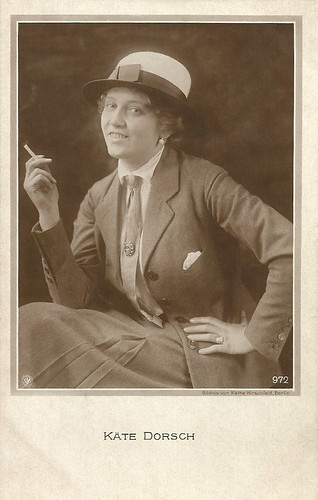
German postcard by NPG (Neue Photographische Gesellschaft), no. 972. Photo: Käthe Hirschfeld, Berlin.
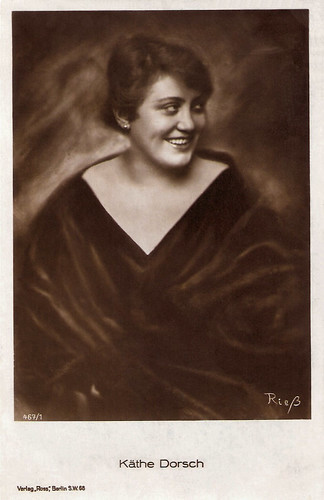
German postcard by Ross Verlag, no. 467/1, 1919-1924. Photo: Riess.
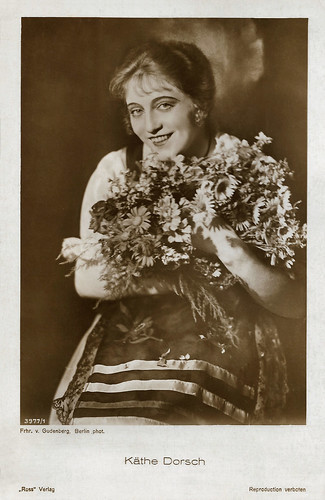
German postcard by Ross Verlag, no. 3977/1, 1928-1929. Photo: Frhr. v. Gudenberg, Berlin.
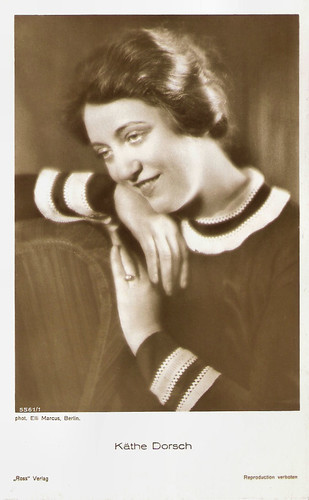
German postcard by Ross Verlag, no. 5561/1, 1930-1931. Photo: Elli Marcus, Berlin.
Operetta Soubrette
Katharina Dorsch was born in Neumarkt in der Oberpfalz, Germany in 1890. She was the daughter of a gingerbread baker from Nürnberg (Neurenberg).
After commercial school, she followed piano classes, and as a fifteen-year-old, she started singing in a choir in Neurenberg, and subsequently in operettas in Hanau and Mannheim.
Her career really started in 1908 as an operetta soubrette with a performance in 'Wiener Blut'(Vienna Blood) in Mainz, and in 1911 she moved to Berlin for an engagement at the Neue Operettentheater. More Berlin engagements followed in theatres like the Lessingtheater and the Deutschen Theater.
As early as 1913, Käthe Dorsch, had her first film role in the short, silent comedy Wenn die Taxe springt/When the Rates Jump (Danny Kaden, 1913). In 1920 she married colleague film star Harry Liedtke , with whom she had appeared in the fairy tale Dornröschen/Sleeping Beauty (Paul Leni, 1917). They were a couple for eight years.
She played in several films, including Der Blusenkönig/The King of Blouses (Ernst Lubitsch, 1917), Erborgtes Glück/Hided Happiness (Arthur Wellin, 1919) with Alexander Moissi , and the August Strindberg adaptation Fräulein Julie/Miss Julie (Felix Basch, 1921) with Asta Nielsen .
After Muss die Frau Mutter werden?/Paragraph 144 (Georg Jacoby, Hans Otto Löwenstein, 1924) opposite Harry Liedtke , she retired from the film business and devoted herself exclusively to the theatre where she became one of the great actresses of her time. In 1927 she started to work in Vienna and appeared there at the Volkstheater. From 1939 till her death she was a permanent member of the Burgtheater. From 1951 she also appeared again on the stages of Berlin.
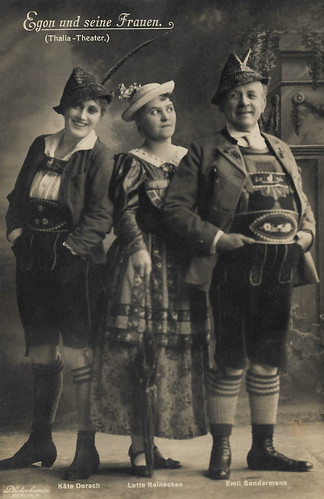
German postcard by Photochemie, Berlin. Photo: Käthe Dorsch, Lotte Reinecken and Emil Sondermann in the stage play 'Egon und seine Frauen' (Egon and his wives) at the Thalia-Theater, Berlin.
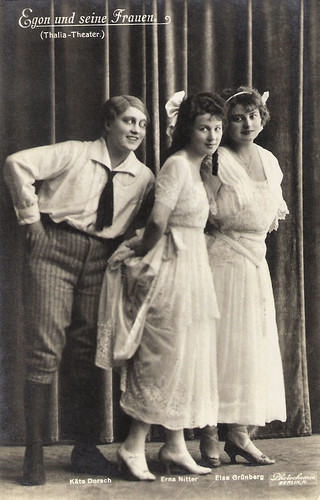
German postcard by Photochemie, Berlin. Photo: Käthe Dorsch, Erna Ritter and Elsa Grünberg in the stage play 'Egon und seine Frauen' (Egon and his wives) at the Thalia-Theater, Berlin.
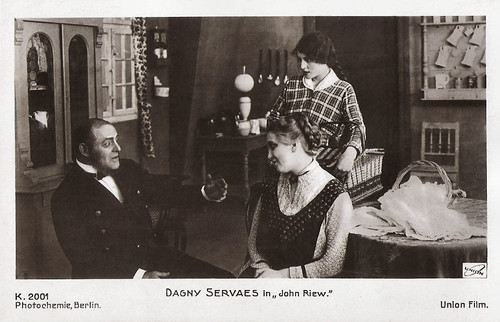
German postcard by Photochemie, Berlin, no. K. 2001. Photo: Union Film. Publicity still for John Riew (Walter Schmidthässler, 1917) with Karl Valentin, Dagny Servaes and Käthe Dorsch.
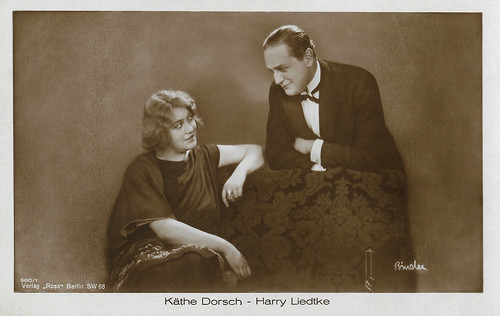
German postcard by Ross Verlag, no. 980/1, 1925-1926. Photo: Alex Binder. Käthe Dorsch and Harry Liedtke in Muß die Frau Mutter werden/Paragraph 144 (Georg Jacoby, Hans Otto, 1924).
Media Scandal
The sound film offered Käthe Dorsch more possibilities than the silent cinema to express herself. After a long interval, she appeared again in the film Die Lindenwirtin/The Linden Tree Landlady (Georg Jacoby, 1930) with Hans Heinz Bollmann.
She impersonated important women like Maria Theresia in Trenck, der Pandur/Trenck, the Pandur (Herbert Selpin, 1940) and Friederike Caroline Neuber in the melodrama Komödianten/The Comedians (Georg Wilhelm Pabst, 1941).
Other popular films in which she appeared were Drei Tage Liebe/Three Days of Love (Heinz Hilpert, 1931) opposite Hans Albers , the murder mystery Savoy-Hotel 217 (Gustav Ucicky, 1936) again opposite Albers, the Oscar Wilde adaptation Eine Frau ohne Bedeutung/A Woman of No Importance (Hans Steinhoff, 1936), Mutterliebe/Mother Love (Gustav Ucicky, 1939), and Morgen werde ich verhaftet/Tomorrow I Will Be Arrested (Karl-Heinz Stroux, 1939) with Ferdinand Marian .
During the war, she played a heroic role by saving colleagues in trouble. For this, she used her friendship with Hermann Göring, whom she knew from childhood. After the war, she devoted herself to the Burgtheater for which she played major parts in classic plays.
Incidentally, she appeared in films like Singende Engel/Singing Angels (Gustav Ucicky, 1947) with Hans Holt , Fahrt ins Glück/Journey Into Happiness (Erich Engel, 1948) with Rudolf Forster and Hildegard Knef , the melodrama Der Bagnosträfling/The Bagno Convict (1949, Gustav Fröhlich) with Paul Dahlke , Das Kuckucksei/The Cuckoo’s Egg (Walter Firner, 1949) with Curd Jürgens , and Regine (Harald Braun, 1955) with Horst Buchholz .
In 1956 she caused a media scandal when she slapped Vienna theatre critic Hans Weigel in the face in broad daylight. In the following trial, she was condemned to pay 500 Schilling.
Käthe Dorsch died in 1957, in Vienna, Austria. She determined her heritage for a foundation to help poor artists. This foundation still exists today. In Vienna, there is now a Käthe-Dorsch-Gasse, and in Berlin, a street is called the Käthe-Dorsch-Ring.
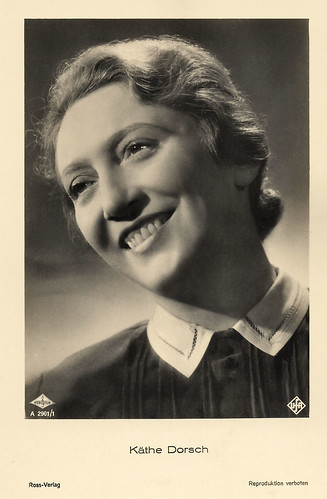
German postcard by Ross Verlag, no. A 2901/1, 1939-1940. Photo: Wien-Film / Ufa.
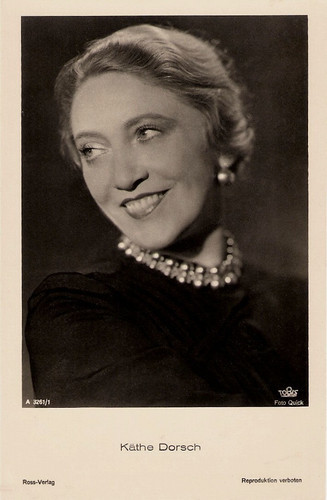
German postcard by Ross Verlag, no. A 3271/1, 1941-1944. Photo: Quick / Tobis.
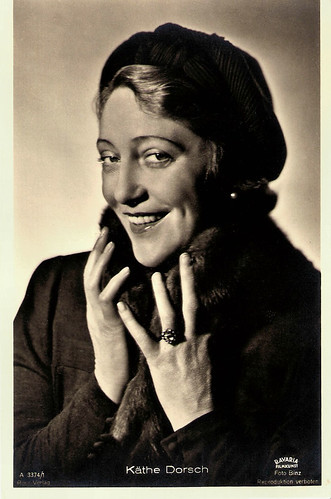
German postcard by Ross Verlag, no. A 3374/1, 1941-1944. Photo: Bavaria Filmkunst / Tita Binz.
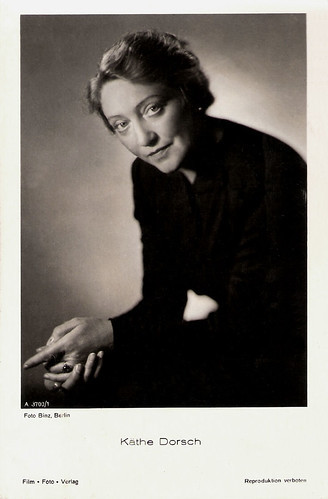
German postcard by Film-Foto-Verlag, no. A 3700/1, 1941-1944. Photo: Binz, Berlin.
Sources: Thomas Staedeli (Cyranos), Steffi-line.de (German), Wikipedia (German), and .

German postcard by NPG (Neue Photographische Gesellschaft), no. 972. Photo: Käthe Hirschfeld, Berlin.

German postcard by Ross Verlag, no. 467/1, 1919-1924. Photo: Riess.

German postcard by Ross Verlag, no. 3977/1, 1928-1929. Photo: Frhr. v. Gudenberg, Berlin.

German postcard by Ross Verlag, no. 5561/1, 1930-1931. Photo: Elli Marcus, Berlin.
Operetta Soubrette
Katharina Dorsch was born in Neumarkt in der Oberpfalz, Germany in 1890. She was the daughter of a gingerbread baker from Nürnberg (Neurenberg).
After commercial school, she followed piano classes, and as a fifteen-year-old, she started singing in a choir in Neurenberg, and subsequently in operettas in Hanau and Mannheim.
Her career really started in 1908 as an operetta soubrette with a performance in 'Wiener Blut'(Vienna Blood) in Mainz, and in 1911 she moved to Berlin for an engagement at the Neue Operettentheater. More Berlin engagements followed in theatres like the Lessingtheater and the Deutschen Theater.
As early as 1913, Käthe Dorsch, had her first film role in the short, silent comedy Wenn die Taxe springt/When the Rates Jump (Danny Kaden, 1913). In 1920 she married colleague film star Harry Liedtke , with whom she had appeared in the fairy tale Dornröschen/Sleeping Beauty (Paul Leni, 1917). They were a couple for eight years.
She played in several films, including Der Blusenkönig/The King of Blouses (Ernst Lubitsch, 1917), Erborgtes Glück/Hided Happiness (Arthur Wellin, 1919) with Alexander Moissi , and the August Strindberg adaptation Fräulein Julie/Miss Julie (Felix Basch, 1921) with Asta Nielsen .
After Muss die Frau Mutter werden?/Paragraph 144 (Georg Jacoby, Hans Otto Löwenstein, 1924) opposite Harry Liedtke , she retired from the film business and devoted herself exclusively to the theatre where she became one of the great actresses of her time. In 1927 she started to work in Vienna and appeared there at the Volkstheater. From 1939 till her death she was a permanent member of the Burgtheater. From 1951 she also appeared again on the stages of Berlin.

German postcard by Photochemie, Berlin. Photo: Käthe Dorsch, Lotte Reinecken and Emil Sondermann in the stage play 'Egon und seine Frauen' (Egon and his wives) at the Thalia-Theater, Berlin.

German postcard by Photochemie, Berlin. Photo: Käthe Dorsch, Erna Ritter and Elsa Grünberg in the stage play 'Egon und seine Frauen' (Egon and his wives) at the Thalia-Theater, Berlin.

German postcard by Photochemie, Berlin, no. K. 2001. Photo: Union Film. Publicity still for John Riew (Walter Schmidthässler, 1917) with Karl Valentin, Dagny Servaes and Käthe Dorsch.

German postcard by Ross Verlag, no. 980/1, 1925-1926. Photo: Alex Binder. Käthe Dorsch and Harry Liedtke in Muß die Frau Mutter werden/Paragraph 144 (Georg Jacoby, Hans Otto, 1924).
Media Scandal
The sound film offered Käthe Dorsch more possibilities than the silent cinema to express herself. After a long interval, she appeared again in the film Die Lindenwirtin/The Linden Tree Landlady (Georg Jacoby, 1930) with Hans Heinz Bollmann.
She impersonated important women like Maria Theresia in Trenck, der Pandur/Trenck, the Pandur (Herbert Selpin, 1940) and Friederike Caroline Neuber in the melodrama Komödianten/The Comedians (Georg Wilhelm Pabst, 1941).
Other popular films in which she appeared were Drei Tage Liebe/Three Days of Love (Heinz Hilpert, 1931) opposite Hans Albers , the murder mystery Savoy-Hotel 217 (Gustav Ucicky, 1936) again opposite Albers, the Oscar Wilde adaptation Eine Frau ohne Bedeutung/A Woman of No Importance (Hans Steinhoff, 1936), Mutterliebe/Mother Love (Gustav Ucicky, 1939), and Morgen werde ich verhaftet/Tomorrow I Will Be Arrested (Karl-Heinz Stroux, 1939) with Ferdinand Marian .
During the war, she played a heroic role by saving colleagues in trouble. For this, she used her friendship with Hermann Göring, whom she knew from childhood. After the war, she devoted herself to the Burgtheater for which she played major parts in classic plays.
Incidentally, she appeared in films like Singende Engel/Singing Angels (Gustav Ucicky, 1947) with Hans Holt , Fahrt ins Glück/Journey Into Happiness (Erich Engel, 1948) with Rudolf Forster and Hildegard Knef , the melodrama Der Bagnosträfling/The Bagno Convict (1949, Gustav Fröhlich) with Paul Dahlke , Das Kuckucksei/The Cuckoo’s Egg (Walter Firner, 1949) with Curd Jürgens , and Regine (Harald Braun, 1955) with Horst Buchholz .
In 1956 she caused a media scandal when she slapped Vienna theatre critic Hans Weigel in the face in broad daylight. In the following trial, she was condemned to pay 500 Schilling.
Käthe Dorsch died in 1957, in Vienna, Austria. She determined her heritage for a foundation to help poor artists. This foundation still exists today. In Vienna, there is now a Käthe-Dorsch-Gasse, and in Berlin, a street is called the Käthe-Dorsch-Ring.

German postcard by Ross Verlag, no. A 2901/1, 1939-1940. Photo: Wien-Film / Ufa.

German postcard by Ross Verlag, no. A 3271/1, 1941-1944. Photo: Quick / Tobis.

German postcard by Ross Verlag, no. A 3374/1, 1941-1944. Photo: Bavaria Filmkunst / Tita Binz.

German postcard by Film-Foto-Verlag, no. A 3700/1, 1941-1944. Photo: Binz, Berlin.
Sources: Thomas Staedeli (Cyranos), Steffi-line.de (German), Wikipedia (German), and .
Published on May 14, 2020 22:00
May 13, 2020
Photo by Foulsham & Banfield
Foulsham & Banfield was a British photographic portrait studio, which was active between the 1900s and the 1920s. The studio was first located in Wigmore Street and later in Old Bond Street, London. The two photographers were Frank Foulsham (1873-1930) and Arthur Clive Banfield (1875-1965). They marketed themselves as specialists in glossy pictures of so-called matinée idols of the West End theatre. We selected 20 postcards with these pictures of stage idols, published by Rotary, and also later pictures of film stars, published in the Picturegoer Series.
Rotary Photo
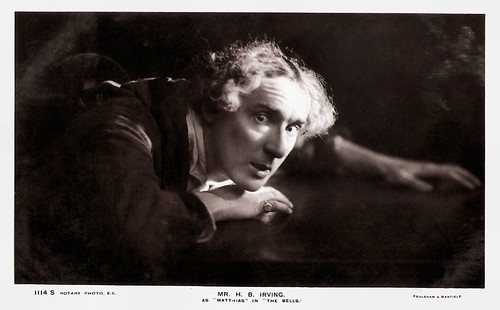
British postcard by Rotary Photo, no. 1114 S. Photo: Foulsham & Banfield. Photo: publicity still for the stage production of 'The Bells' (ca. 1905) with H.B. Irving as Matthias.
H.B. Irving (1870-1919) was a British stage actor and actor-manager. He was the eldest son of Sir Henry Irving. Despite his many roles on stage and in the silent cinema, Irving is now best known for 'A Book of Remarkable Criminals' (1918), which he wrote as a legal expert.
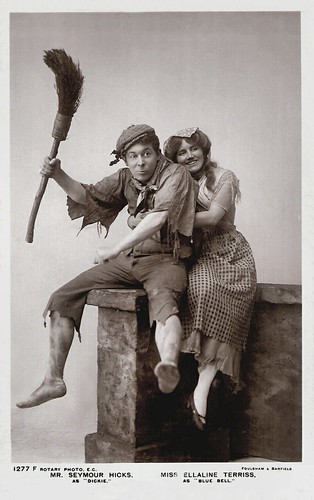
British postcard by Rotary, no. 1277 F. Photo: Foulsham & Banfield. Seymour Hicks as Dickie and Ellaline Terriss as Blue Bell in the play 'Bluebell in Fairyland' (1901).
Suave Seymour Hicks (1871-1949) was a successful British actor, music hall performer, playwright, screenwriter, actor-manager and producer. He became known, early in his career, for writing, starring in and producing several Edwardian musical comedies, often together with his famous wife, Ellaline Terriss. His most popular role was that of Ebenezer Scrooge in Charles Dickens's A Christmas Carol. He repeated this role on screen in a silent and in a sound version.
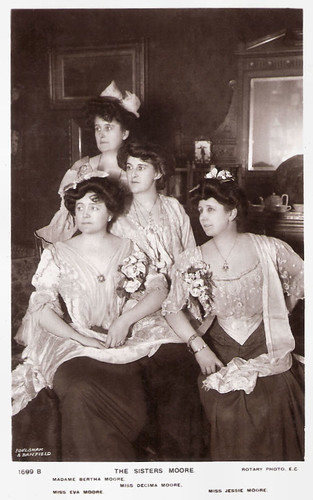
British postcard in the Rotary Photographic Series, no. 1699 B. Photo: Foulsham & Banfield. Eva, Decima, Bertha, and Jessie Moore.
English actress Eva Moore (1870–1955) had a career on stage and in the cinema which spanned six decades. She was active in the women's suffrage movement, and from 1920 on she appeared in over two dozen films.
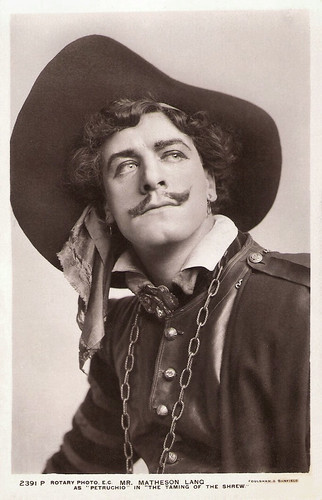
British postcard by Rotary, no. 2391 P. Photo: Foulsham & Banfield. Matheson Lang as Petruchio in the play 'The Taming of the Shrew'.
Tall and good-looking Matheson Lang (1879-1948) was a Canadian-born stage and film actor and playwright in the early 20th century. He is best known for his Shakespearean roles in British productions of 'Hamlet', 'Macbeth', and 'Romeo and Juliet' and for his role as Mr. Wu. He was one of the first major stars of the British theatre who acted in a silent film and during the 1920s, he became a popular film star in Great Britain.
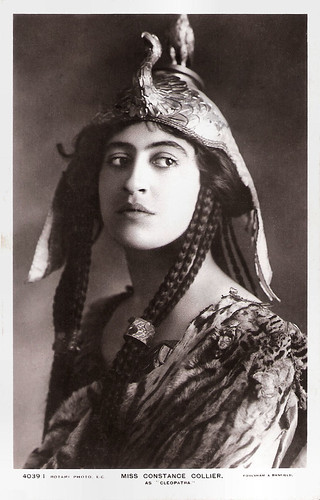
British postcard by Rotary Photo, no. 4039 I. Photo: Foulsham & Banfield. Publicity still for the stage production 'Antony and Cleopatra' (1906) with Constance Collier as Cleopatra.
Constance Collier (1878–1955) was an English stage and film actress and later one of Hollywood's premiere drama and voice coaches. In a career that covered six decades, she evolved into one of London’s and Broadway’s finest tragediennes. Although she appeared in a number of silent British and American films, her career in the cinema got really on steam in her senior years when Collier appeared in well-regarded supporting roles in more than twenty Hollywood productions.
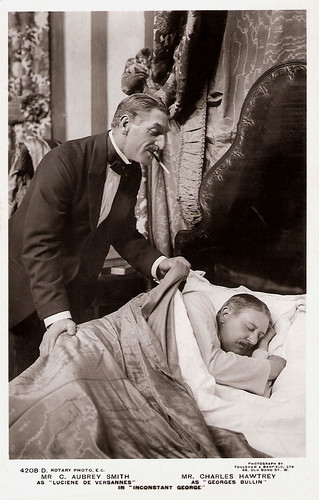
British postcard in the Rotary Photographic Series, no. 4208D. Photo: Foulsham & Banfield, London. Publicity still for the play 'Inconstant George' with Charles Hawtrey as Georges Bullin and C. Aubrey Smith as Luciene de Versannes. The play written by Gladys B. Unger and directed by Charles Hawtrey was performed during the 1910-1911 season at the Prince of Wales Theatre in London.
C. Aubrey Smith (1863–1948) was an English cricketer and actor, who started his film career in the British silent cinema. He went to Hollywood where he had a successful career as a character actor playing stereotypical Englishmen with a stiff upper lip and a stern determination. His bushy eyebrows, beady eyes, and handlebar moustache made him one of the most recognisable faces of the cinema.
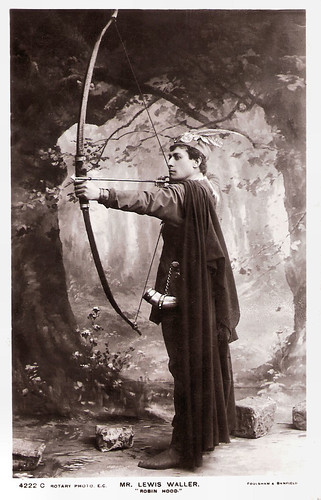
British postcard by Rotary Photo, E.C., no. 4222 C. Photo: Foulsham & Banfield. Lewis Waller in the stage production 'Robin Hood' (1906).
Lewis Waller (1860-1915) was best known as a matinee-idol in the popular romantic plays of his day. He also worked as a playwriter and a stage manager and appeared in several films.
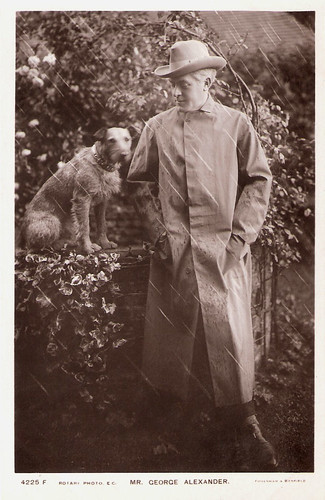
British postcard by Rotary, no. 4225 F. Photo: Foulsham and Banfield.
Sir George Alexander (1858-1918) was an English actor and theatre manager, who produced and starred in Oscar Wilde's plays 'Lady Windermere's Fan' and 'The Importance of Being Ernest'. He also acted in two silent films and is the great, great uncle of Hugh Laurie.
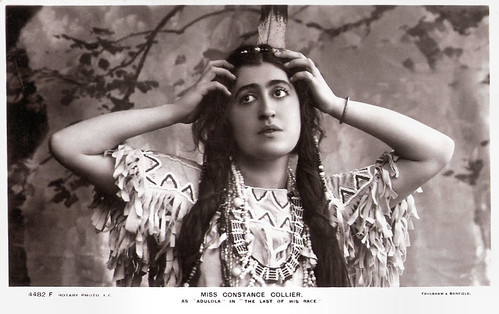
British postcard by Rotary Photo, no. 4482 F. Photo: Foulsham & Banfield. Publicity still for the stage production The Last of His Race (1907) with Constance Collier as Adulola.
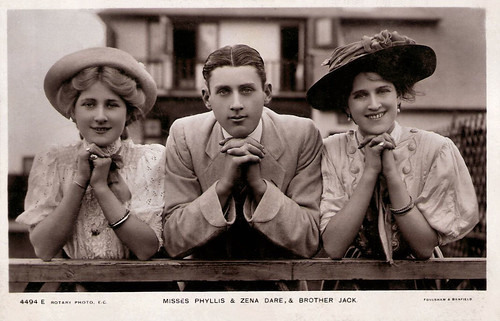
British postcard by Rotary Photo, no. 4494 E. Photo: Foulsham & Banfield. Phyllis, Jack and Zena Dare.
English singer and actress Phyllis Dare (1890-1975) was famous for her performances in Edwardian musical comedy and other musical theatre in the first half of the 20th century. She appeared occasionally in films and was one of the leading Picture Postcard beauties of the Belle Epoque. English singer and actress Zena Dare (1887–1975) was famous for her charming, graceful and vivacious performances in Edwardian musicals and comedies in the first decade of the 20th century. Decades later she again enjoyed great success with her role as Mrs. Higgins in the long-running original London production of 'My Fair Lady'. She also made several appearances on film and television.
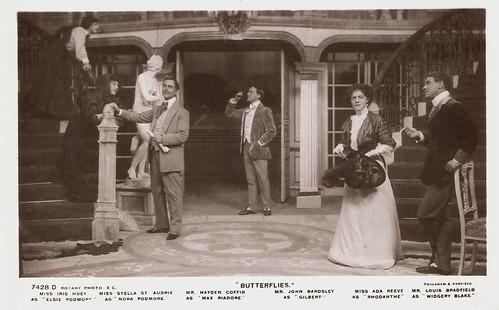
British postcard by Rotary Photo, no. 7428 D. Photo: Foulsham & Banfield. Publicity still for the stage play 'Butterflies' with Iris Hoey, Stella St. Audrie, C. Hayden Coffin, John Bardsley, Ada Reeve , and Louis Bradfield. 'Butterflies' is a musical play in three acts by William J. Locke, lyrics by T.H. Read and music by J.A. Robertson. Produced at the Apollo Theatre, London in 1908.
British stage and film actress Ada Reeve (1874-1966) was much loved on three continents. She was one of the most popular British singing comediennes of all time and considered to be a headliner in variety and vaudeville. She was endowed with a softness of voice and delicacy of performance that quite set her apart from virtually all of her more raucous contemporaries in the music halls and popularised many memorable songs.
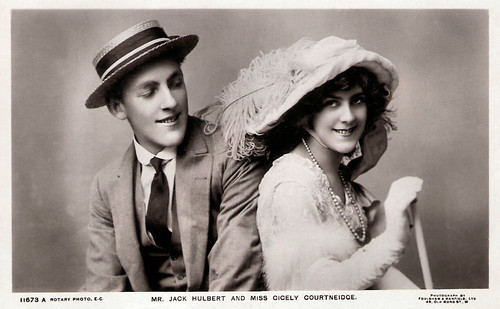
British postcard in the Rotary Photographic Series, no. 11673 A. Photo: Foulsham & Banfield.
British actor Jack Hulbert (1892-1978) was a popular comedian of the 1930s with a trademark chiselled chin. In his musicals, he often appeared with his wife Cicely Courtneidge. British actress Cicely Courtneidge (1893–1980) was an elegantly knockabout comedienne. For 62 years, she formed a husband and wife team with comedian Jack Hulbert on stage, radio, TV and in the cinema. During the 1930s she also starred in eleven British films and one disastrous American production.
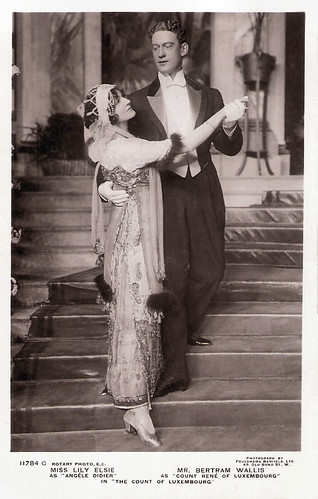
British postcard by Rotary Photo, E.C., no. 11784 C. Photo: Foulsham & Banfield, Ltd. Bertram Wallis and Lily Elsie in 'The Count of Luxembourg', an operetta in two acts with English lyrics and libretto by Basil Hood and Adrian Ross, music by Franz Lehár, based on Lehár's three-act German operetta 'Der Graf von Luxemburg' which had premiered in Vienna in 1909. The original production opened at Daly's Theatre in London in 1911 and ran for 345 performances, starring Lily Elsie, Huntley Wright, W. H. Berry, and Bertram Wallis .
Tall and handsome Bertram Wallis (1874-1952) was a renowned English actor and singer. He was a glamorous matinée idol in popular plays and musical comedies in the early 20th century. Between the two wars, he also appeared in several films. Lily Elsie (1886-1962) basically was an Edwardian music hall singer and actress, who conquered British audiences overnight in 1907 with her role in 'The Merry Widow', but she also performed in two films: The Great Love (1918) by D.W. Griffith and the British film Comradeship (Maurice Elvey 1919).
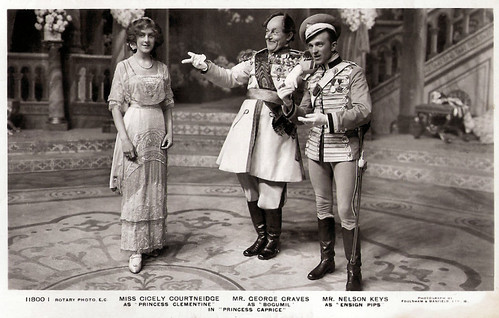
British postcard by Rotary Photo, no. 11800 I. Photo: Foulsham & Banfield Ltd. Cicely Courtneidge as Princess Clementine, George Graves as Bugumil, and Nelson Keyes as Ensign Pips in 'Princess Caprice' (1912). 'Princess Caprice' is a comedy with music, in three acts, with music by Leo Fall. The original production opened at the Shaftesbury Theatre, London, on 11 May 1912, running for 265 performances until January 1913. It was produced by Robert Courtneidge.
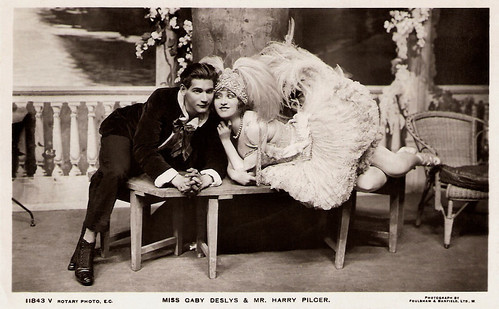
British postcard by Rotary Photo, no. 11843 V. Photo: Foulsham & Banfield.
American actor, dancer, choreographer, and lyricist Harry Pilcer (1885-1961) is mainly remembered for his association with French diva Gaby Deslys (1881-1920). He composed a waltz for her, 'The Gaby Glide', which they danced together on Broadway in 'Vera Violetta' (1911-1912). They appeared in three more Broadway musicals together.
The Picturegoer Series
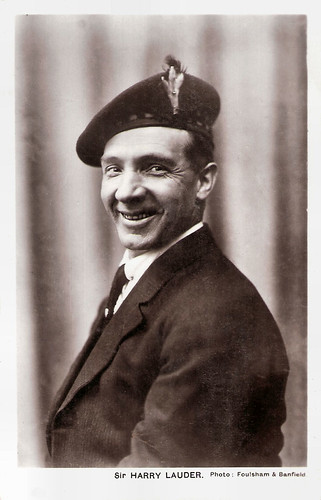
British postcard in the Picturegoer Series, London, no. T 2. Photo: Foulsham & Banfield.
Scottish music hall and vaudeville theatre singer and comedian Sir Harry Lauder (1870-1950) was perhaps best known for his long-standing hit 'I Love a Lassie' and his other simplehearted Scottish songs. With his performances, he promoted the kilt and the 'cromach' (walking stick) worldwide, especially in America. By 1911, Lauder had become the highest-paid performer in the world and was the first Scottish artist to sell a million records. He raised huge amounts of money for the war effort during World War I, for which he was subsequently knighted in 1919. He appeared in several films.
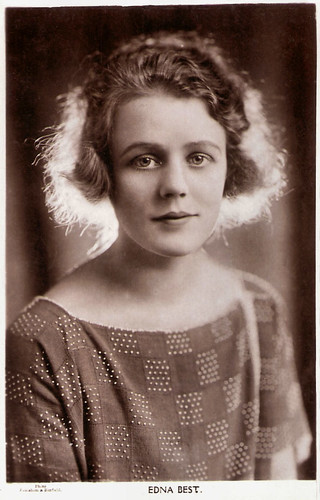
British postcard in the Picturegoer Series, London, no. 71. Photo: Foulsham & Banfield.
British actress Edna Best (1900-1974) was known on the London stage before she entered films in 1921. She is best remembered for her role as the mother in the original 1934 film version of Alfred Hitchcock's The Man Who Knew Too Much. Among her other film credits are Intermezzo: A Love Story (1939), Swiss Family Robinson (1940), The Ghost and Mrs. Muir (1947) and The Iron Curtain (1948).
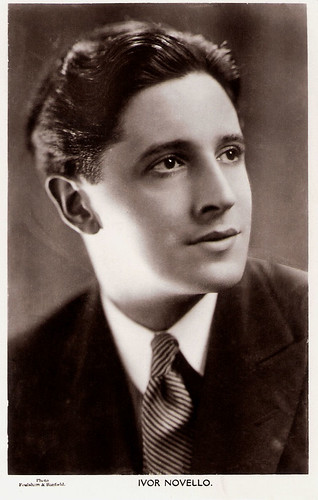
British postcard in the Picturegoer Series, London, no. 82. Photo: Foulsham & Banfield.
Ivor Novello (1893-1951) was one of the most famous matinee idols, writers and composers of the British stage during the early part of the 20th century.
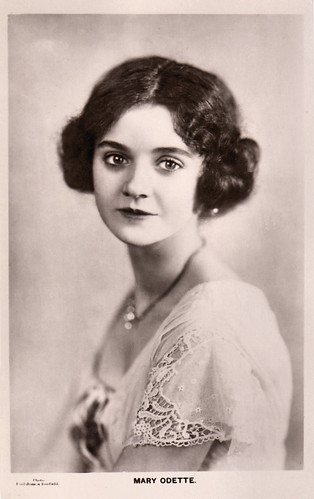
British postcard in the Picturegoer Series, no. 190. Photo: Foulsham & Banfield. Collection: Marlene Pilaete.
Mary Odette (1901-1987) was a French actress who starred in British, Dutch, German and French silent films.
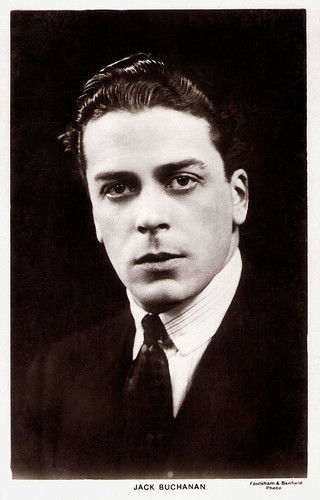
British postcard by Real Photograph in the Picturegoer Series, London, no. 227. Photo: Foulsham & Banfield.
Tall and slim actor and singer Jack Buchanan (1891-1957) was known for three decades as the embodiment of the quintessential Englishman, despite being a Scot. During his career, he was one of the major British screen stars of his day and incarnated the elegant, always immaculately clothed man about town in about three dozen films. In America, he is best known for his role opposite Fred Astaire in the classic Hollywood musical The Band Wagon (1953).
Sources: Elena Cooper (Art and Modern Copyright: The Contested Image), and Wikipedia Commons.
Rotary Photo

British postcard by Rotary Photo, no. 1114 S. Photo: Foulsham & Banfield. Photo: publicity still for the stage production of 'The Bells' (ca. 1905) with H.B. Irving as Matthias.
H.B. Irving (1870-1919) was a British stage actor and actor-manager. He was the eldest son of Sir Henry Irving. Despite his many roles on stage and in the silent cinema, Irving is now best known for 'A Book of Remarkable Criminals' (1918), which he wrote as a legal expert.

British postcard by Rotary, no. 1277 F. Photo: Foulsham & Banfield. Seymour Hicks as Dickie and Ellaline Terriss as Blue Bell in the play 'Bluebell in Fairyland' (1901).
Suave Seymour Hicks (1871-1949) was a successful British actor, music hall performer, playwright, screenwriter, actor-manager and producer. He became known, early in his career, for writing, starring in and producing several Edwardian musical comedies, often together with his famous wife, Ellaline Terriss. His most popular role was that of Ebenezer Scrooge in Charles Dickens's A Christmas Carol. He repeated this role on screen in a silent and in a sound version.

British postcard in the Rotary Photographic Series, no. 1699 B. Photo: Foulsham & Banfield. Eva, Decima, Bertha, and Jessie Moore.
English actress Eva Moore (1870–1955) had a career on stage and in the cinema which spanned six decades. She was active in the women's suffrage movement, and from 1920 on she appeared in over two dozen films.

British postcard by Rotary, no. 2391 P. Photo: Foulsham & Banfield. Matheson Lang as Petruchio in the play 'The Taming of the Shrew'.
Tall and good-looking Matheson Lang (1879-1948) was a Canadian-born stage and film actor and playwright in the early 20th century. He is best known for his Shakespearean roles in British productions of 'Hamlet', 'Macbeth', and 'Romeo and Juliet' and for his role as Mr. Wu. He was one of the first major stars of the British theatre who acted in a silent film and during the 1920s, he became a popular film star in Great Britain.

British postcard by Rotary Photo, no. 4039 I. Photo: Foulsham & Banfield. Publicity still for the stage production 'Antony and Cleopatra' (1906) with Constance Collier as Cleopatra.
Constance Collier (1878–1955) was an English stage and film actress and later one of Hollywood's premiere drama and voice coaches. In a career that covered six decades, she evolved into one of London’s and Broadway’s finest tragediennes. Although she appeared in a number of silent British and American films, her career in the cinema got really on steam in her senior years when Collier appeared in well-regarded supporting roles in more than twenty Hollywood productions.

British postcard in the Rotary Photographic Series, no. 4208D. Photo: Foulsham & Banfield, London. Publicity still for the play 'Inconstant George' with Charles Hawtrey as Georges Bullin and C. Aubrey Smith as Luciene de Versannes. The play written by Gladys B. Unger and directed by Charles Hawtrey was performed during the 1910-1911 season at the Prince of Wales Theatre in London.
C. Aubrey Smith (1863–1948) was an English cricketer and actor, who started his film career in the British silent cinema. He went to Hollywood where he had a successful career as a character actor playing stereotypical Englishmen with a stiff upper lip and a stern determination. His bushy eyebrows, beady eyes, and handlebar moustache made him one of the most recognisable faces of the cinema.

British postcard by Rotary Photo, E.C., no. 4222 C. Photo: Foulsham & Banfield. Lewis Waller in the stage production 'Robin Hood' (1906).
Lewis Waller (1860-1915) was best known as a matinee-idol in the popular romantic plays of his day. He also worked as a playwriter and a stage manager and appeared in several films.

British postcard by Rotary, no. 4225 F. Photo: Foulsham and Banfield.
Sir George Alexander (1858-1918) was an English actor and theatre manager, who produced and starred in Oscar Wilde's plays 'Lady Windermere's Fan' and 'The Importance of Being Ernest'. He also acted in two silent films and is the great, great uncle of Hugh Laurie.

British postcard by Rotary Photo, no. 4482 F. Photo: Foulsham & Banfield. Publicity still for the stage production The Last of His Race (1907) with Constance Collier as Adulola.

British postcard by Rotary Photo, no. 4494 E. Photo: Foulsham & Banfield. Phyllis, Jack and Zena Dare.
English singer and actress Phyllis Dare (1890-1975) was famous for her performances in Edwardian musical comedy and other musical theatre in the first half of the 20th century. She appeared occasionally in films and was one of the leading Picture Postcard beauties of the Belle Epoque. English singer and actress Zena Dare (1887–1975) was famous for her charming, graceful and vivacious performances in Edwardian musicals and comedies in the first decade of the 20th century. Decades later she again enjoyed great success with her role as Mrs. Higgins in the long-running original London production of 'My Fair Lady'. She also made several appearances on film and television.

British postcard by Rotary Photo, no. 7428 D. Photo: Foulsham & Banfield. Publicity still for the stage play 'Butterflies' with Iris Hoey, Stella St. Audrie, C. Hayden Coffin, John Bardsley, Ada Reeve , and Louis Bradfield. 'Butterflies' is a musical play in three acts by William J. Locke, lyrics by T.H. Read and music by J.A. Robertson. Produced at the Apollo Theatre, London in 1908.
British stage and film actress Ada Reeve (1874-1966) was much loved on three continents. She was one of the most popular British singing comediennes of all time and considered to be a headliner in variety and vaudeville. She was endowed with a softness of voice and delicacy of performance that quite set her apart from virtually all of her more raucous contemporaries in the music halls and popularised many memorable songs.

British postcard in the Rotary Photographic Series, no. 11673 A. Photo: Foulsham & Banfield.
British actor Jack Hulbert (1892-1978) was a popular comedian of the 1930s with a trademark chiselled chin. In his musicals, he often appeared with his wife Cicely Courtneidge. British actress Cicely Courtneidge (1893–1980) was an elegantly knockabout comedienne. For 62 years, she formed a husband and wife team with comedian Jack Hulbert on stage, radio, TV and in the cinema. During the 1930s she also starred in eleven British films and one disastrous American production.

British postcard by Rotary Photo, E.C., no. 11784 C. Photo: Foulsham & Banfield, Ltd. Bertram Wallis and Lily Elsie in 'The Count of Luxembourg', an operetta in two acts with English lyrics and libretto by Basil Hood and Adrian Ross, music by Franz Lehár, based on Lehár's three-act German operetta 'Der Graf von Luxemburg' which had premiered in Vienna in 1909. The original production opened at Daly's Theatre in London in 1911 and ran for 345 performances, starring Lily Elsie, Huntley Wright, W. H. Berry, and Bertram Wallis .
Tall and handsome Bertram Wallis (1874-1952) was a renowned English actor and singer. He was a glamorous matinée idol in popular plays and musical comedies in the early 20th century. Between the two wars, he also appeared in several films. Lily Elsie (1886-1962) basically was an Edwardian music hall singer and actress, who conquered British audiences overnight in 1907 with her role in 'The Merry Widow', but she also performed in two films: The Great Love (1918) by D.W. Griffith and the British film Comradeship (Maurice Elvey 1919).

British postcard by Rotary Photo, no. 11800 I. Photo: Foulsham & Banfield Ltd. Cicely Courtneidge as Princess Clementine, George Graves as Bugumil, and Nelson Keyes as Ensign Pips in 'Princess Caprice' (1912). 'Princess Caprice' is a comedy with music, in three acts, with music by Leo Fall. The original production opened at the Shaftesbury Theatre, London, on 11 May 1912, running for 265 performances until January 1913. It was produced by Robert Courtneidge.

British postcard by Rotary Photo, no. 11843 V. Photo: Foulsham & Banfield.
American actor, dancer, choreographer, and lyricist Harry Pilcer (1885-1961) is mainly remembered for his association with French diva Gaby Deslys (1881-1920). He composed a waltz for her, 'The Gaby Glide', which they danced together on Broadway in 'Vera Violetta' (1911-1912). They appeared in three more Broadway musicals together.
The Picturegoer Series

British postcard in the Picturegoer Series, London, no. T 2. Photo: Foulsham & Banfield.
Scottish music hall and vaudeville theatre singer and comedian Sir Harry Lauder (1870-1950) was perhaps best known for his long-standing hit 'I Love a Lassie' and his other simplehearted Scottish songs. With his performances, he promoted the kilt and the 'cromach' (walking stick) worldwide, especially in America. By 1911, Lauder had become the highest-paid performer in the world and was the first Scottish artist to sell a million records. He raised huge amounts of money for the war effort during World War I, for which he was subsequently knighted in 1919. He appeared in several films.

British postcard in the Picturegoer Series, London, no. 71. Photo: Foulsham & Banfield.
British actress Edna Best (1900-1974) was known on the London stage before she entered films in 1921. She is best remembered for her role as the mother in the original 1934 film version of Alfred Hitchcock's The Man Who Knew Too Much. Among her other film credits are Intermezzo: A Love Story (1939), Swiss Family Robinson (1940), The Ghost and Mrs. Muir (1947) and The Iron Curtain (1948).

British postcard in the Picturegoer Series, London, no. 82. Photo: Foulsham & Banfield.
Ivor Novello (1893-1951) was one of the most famous matinee idols, writers and composers of the British stage during the early part of the 20th century.

British postcard in the Picturegoer Series, no. 190. Photo: Foulsham & Banfield. Collection: Marlene Pilaete.
Mary Odette (1901-1987) was a French actress who starred in British, Dutch, German and French silent films.

British postcard by Real Photograph in the Picturegoer Series, London, no. 227. Photo: Foulsham & Banfield.
Tall and slim actor and singer Jack Buchanan (1891-1957) was known for three decades as the embodiment of the quintessential Englishman, despite being a Scot. During his career, he was one of the major British screen stars of his day and incarnated the elegant, always immaculately clothed man about town in about three dozen films. In America, he is best known for his role opposite Fred Astaire in the classic Hollywood musical The Band Wagon (1953).
Sources: Elena Cooper (Art and Modern Copyright: The Contested Image), and Wikipedia Commons.
Published on May 13, 2020 22:00
May 12, 2020
Marcelle Géniat
French stage and screen actress Marcelle Géniat (1881-1959) was a Sociétaire of the Comédie-Française. She also appeared in fifty-three films between 1909 and 1956.
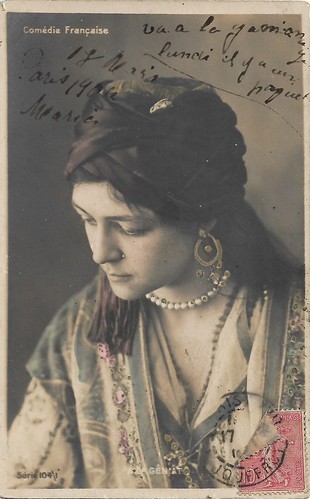
French postcard, series 104-1. Caption: Marcelle Géniat, Comédie Française.
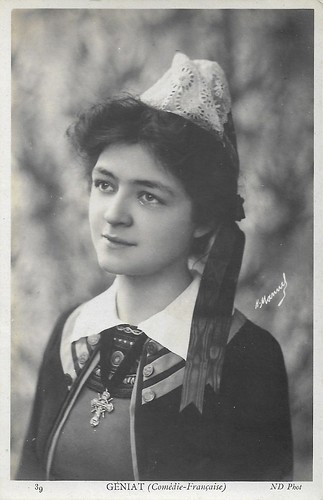
French postcard by ND Phot., no. 39. Photo: Henri Manuel. Caption: Géniat (Comédie-Française).
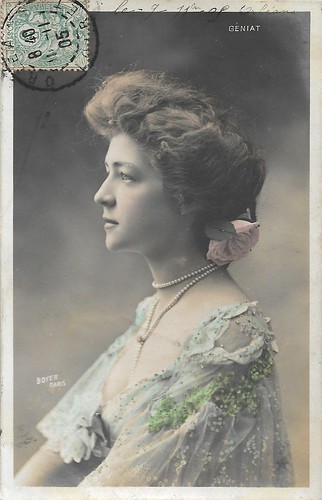
French postcard. Photo: Paul Boyer, Paris. Stamp dated 1905.
Director of a correctional center for girls
Marcelle Géniat was born Eugénie Pauline Martin in Saint Petersburg, Russian Empire, in 1881. Her parents were French.
Very young, Géniat started her career at the theatre. At the age of eight, she already played in Emile Zola's 'L'Assommoir' in Saint Petersburg, alongside Lucien Guitry. Later she attended dance classes.
Back in Paris, she entered the Conservatory of Dramatic Art in 1899 in the Leloir class. After obtaining the first prize in comedy at the Conservatory, she entered the Comédie-Française in 1899. She learned the trade by playing classics like 'Les femmes savantes' by Molière, and 'Andromaque' by Racine, as well as boulevard plays like 'La petite amie' by Eugène Brieux or 'Bagatelle' by Paul Hervieu.
She was very successful in the roles of Aricie in 'Phèdre' and Atalide in 'Bajazet'. She also played in contemporary theatre, such as 'Paraître' by Maurice Donnay, 'Les Fresnay' by Vandérem, 'L'Amour vigil' by de Flers and Caillavet, and 'The Wonderful Flower' by Miguel Zamacoïs.
She also interpreted the heroines of Alexandre Dumas fils, Paul Hervieu, Édouard Pailleron, and Octave Mirbeau. She became a Sociétaire (a member) in 1910 and left in the Comédie Française in 1912.
During the First World War, Marcelle Géniat became a nurse and devoted her care to the wounded
After the war, she made a great career on the boulevards. Her best-known role was as Mademoiselle in the play by Jacques Deval.
In the 1930s, in addition to being an actress, Géniat was also the director of a correctional center for girls in Boulogne-Billancourt.
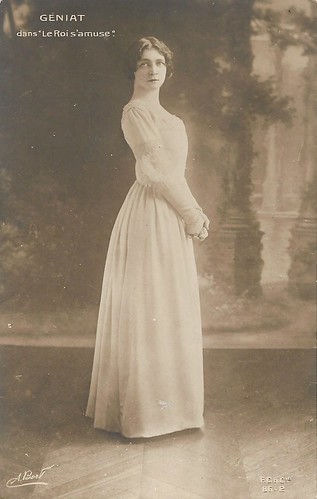
French postcard by FC & Cie, no. 86/2. Photo: A. Bert. Marcelle Géniat in 'Le Roi s'amuse'.
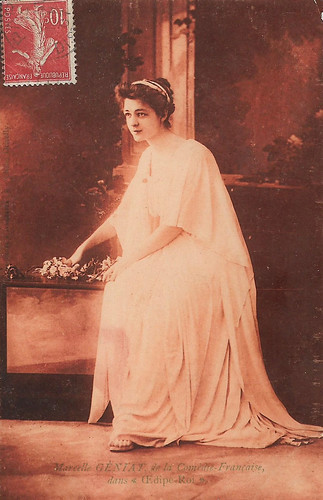
French postcard by Procédés G. Jeangette. Photo: Oricelly. Caption: Marcelle Géniat de la Comédie-Française in 'Oedipe Roi' (Oedipus Rex) by Sophocles. Sophocles' classic tragedy was part of the regular repertory of the Comédie-Française. In 1908 Géniat acted in it in a supporting part, while Mounet-Sully played the title role, and Jocaste was alternatingly acted by Jeanne Delvair and Louise Silvain.
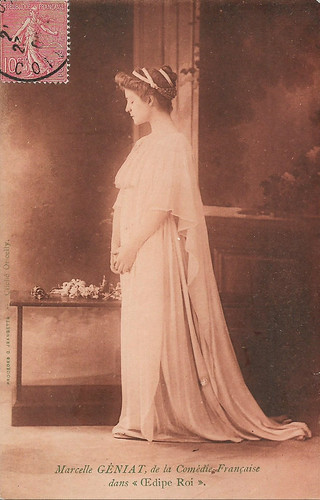
French postcard by Procédés G. Jeangette. Photo: Oricelly. Caption: Marcelle Géniat de la Comédie-Française in 'Oedipe Roi' (Oedipus Rex) by Sophocles.
Becoming blind of witnessing a crime
In the cinema, Marcelle Géniat appeared in fifty-three films between 1909 and 1956. She made her film debut for Pathé Frères in Le roi s'amuse/The king has fun (Albert Capellani, Michel Carré, 1909) with Henri Sylvain . It was followed by another short film for Pathé, Rigoletto (André Calmettes, 1909), starring Paul Mounet.
During the 1910s, she played in four films. These included two films by actor and director Léonce Perret: L’imprévu/The unexpected (1916) with Henry Roussel, and Le retour du passé/The return of the past (1916).
Her largest cinema output was in the French sound film of the 1930s and 1940s. Géniat often played afflicted women such as in La fusée/Grandeur and Decadence (Jacques Nathanson, 1933) with Firmin Gémier .
She had the lead in La joueuse d'orgue/The organ player (Gaston Roudès, 1936), an adaptation of a classic novel by Xavier de Montepin which had already been filmed in 1925. The film deals with a woman who witnessed a crime and became blind because of it.
Géniat also had major parts as La Chouette in the drama Les mystères de Paris/The Mysteries of Paris (Félix Gandéra, 1935) with Lucien Baroux and Madeleine Ozeray , and as the mother of Raimu in L'étrange Monsieur Victor/The Strange Monsieur Victor (Jean Grémillon, 1938).
Her best years in the cinema took place during the occupation between 1940 and 1944 when she appeared in 10 films. These included the horror film Le loup des Malveneur/The Wolf of the Malveneurs (Guillaume Radot, 1942), with Madeleine Sologne and Pierre Renoir , and Le voile bleu/The Blue Veil (Jean Stelli, 1942), with Gaby Morlay . She also appeared in one of the rare Pétainist films, Haut le vent/High the wind (Jacques de Baroncelli, 1942), with Charles Vanel .
During this period, she also obtained her best screen role as Mamouret in Le briseur de chaînes/Chain Breaker (Jacques Daniel-Norman, 1941) opposite Pierre Fresnay . Daniel Chocron at CinéArtistes : "It is also the only time that Marcelle Géniat is the star of a popular film with a substantial budget and distribution, composing a character of anthology with a grumpy air attached to the small pleasures of life but lucid on the darkness of human nature."
Marcelle Géniat died of cancer in 1959 in L'Hay-les-Roses, France. She was 78. She was buried in the Parisian cemetery of Saint-Ouen (Seine-Saint-Denis). Géniat was married to Paul Martel de la Chesnaye. They had a daughter, actress Gilberte Géniat.
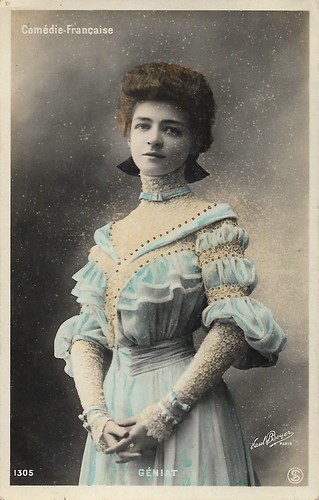
French postcard by SIP, no. 1305. Photo: Paul Boyer, Paris. Caption: Géniat, Comédie-Française.
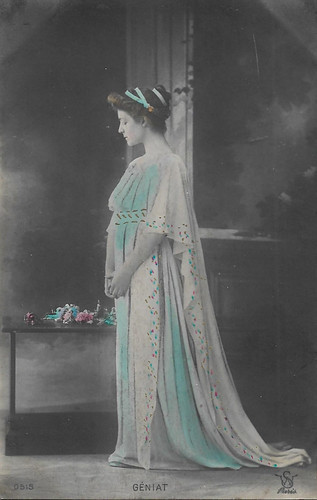
French postcard by WS Paris, no. 0515
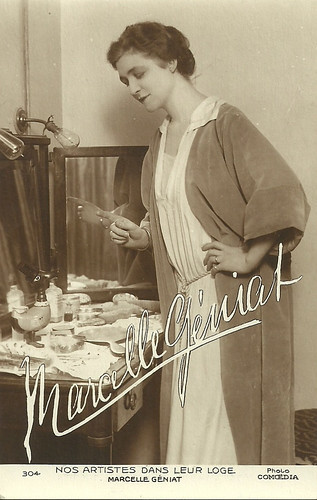
French postcard in the 'Nos artistes dans leur loge' series, no. 304. Photo: Comoedia, Paris.
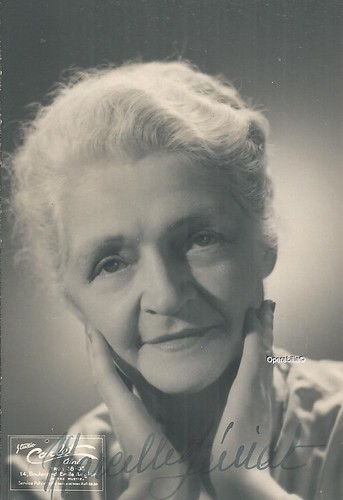
French postcard. Photo: Studio Carlet Ainé. Collection: Claude-Pascal Perna @ Flickr.
Sources: Comédie-Française (French), Wikipedia (English and French), and .

French postcard, series 104-1. Caption: Marcelle Géniat, Comédie Française.

French postcard by ND Phot., no. 39. Photo: Henri Manuel. Caption: Géniat (Comédie-Française).

French postcard. Photo: Paul Boyer, Paris. Stamp dated 1905.
Director of a correctional center for girls
Marcelle Géniat was born Eugénie Pauline Martin in Saint Petersburg, Russian Empire, in 1881. Her parents were French.
Very young, Géniat started her career at the theatre. At the age of eight, she already played in Emile Zola's 'L'Assommoir' in Saint Petersburg, alongside Lucien Guitry. Later she attended dance classes.
Back in Paris, she entered the Conservatory of Dramatic Art in 1899 in the Leloir class. After obtaining the first prize in comedy at the Conservatory, she entered the Comédie-Française in 1899. She learned the trade by playing classics like 'Les femmes savantes' by Molière, and 'Andromaque' by Racine, as well as boulevard plays like 'La petite amie' by Eugène Brieux or 'Bagatelle' by Paul Hervieu.
She was very successful in the roles of Aricie in 'Phèdre' and Atalide in 'Bajazet'. She also played in contemporary theatre, such as 'Paraître' by Maurice Donnay, 'Les Fresnay' by Vandérem, 'L'Amour vigil' by de Flers and Caillavet, and 'The Wonderful Flower' by Miguel Zamacoïs.
She also interpreted the heroines of Alexandre Dumas fils, Paul Hervieu, Édouard Pailleron, and Octave Mirbeau. She became a Sociétaire (a member) in 1910 and left in the Comédie Française in 1912.
During the First World War, Marcelle Géniat became a nurse and devoted her care to the wounded
After the war, she made a great career on the boulevards. Her best-known role was as Mademoiselle in the play by Jacques Deval.
In the 1930s, in addition to being an actress, Géniat was also the director of a correctional center for girls in Boulogne-Billancourt.

French postcard by FC & Cie, no. 86/2. Photo: A. Bert. Marcelle Géniat in 'Le Roi s'amuse'.

French postcard by Procédés G. Jeangette. Photo: Oricelly. Caption: Marcelle Géniat de la Comédie-Française in 'Oedipe Roi' (Oedipus Rex) by Sophocles. Sophocles' classic tragedy was part of the regular repertory of the Comédie-Française. In 1908 Géniat acted in it in a supporting part, while Mounet-Sully played the title role, and Jocaste was alternatingly acted by Jeanne Delvair and Louise Silvain.

French postcard by Procédés G. Jeangette. Photo: Oricelly. Caption: Marcelle Géniat de la Comédie-Française in 'Oedipe Roi' (Oedipus Rex) by Sophocles.
Becoming blind of witnessing a crime
In the cinema, Marcelle Géniat appeared in fifty-three films between 1909 and 1956. She made her film debut for Pathé Frères in Le roi s'amuse/The king has fun (Albert Capellani, Michel Carré, 1909) with Henri Sylvain . It was followed by another short film for Pathé, Rigoletto (André Calmettes, 1909), starring Paul Mounet.
During the 1910s, she played in four films. These included two films by actor and director Léonce Perret: L’imprévu/The unexpected (1916) with Henry Roussel, and Le retour du passé/The return of the past (1916).
Her largest cinema output was in the French sound film of the 1930s and 1940s. Géniat often played afflicted women such as in La fusée/Grandeur and Decadence (Jacques Nathanson, 1933) with Firmin Gémier .
She had the lead in La joueuse d'orgue/The organ player (Gaston Roudès, 1936), an adaptation of a classic novel by Xavier de Montepin which had already been filmed in 1925. The film deals with a woman who witnessed a crime and became blind because of it.
Géniat also had major parts as La Chouette in the drama Les mystères de Paris/The Mysteries of Paris (Félix Gandéra, 1935) with Lucien Baroux and Madeleine Ozeray , and as the mother of Raimu in L'étrange Monsieur Victor/The Strange Monsieur Victor (Jean Grémillon, 1938).
Her best years in the cinema took place during the occupation between 1940 and 1944 when she appeared in 10 films. These included the horror film Le loup des Malveneur/The Wolf of the Malveneurs (Guillaume Radot, 1942), with Madeleine Sologne and Pierre Renoir , and Le voile bleu/The Blue Veil (Jean Stelli, 1942), with Gaby Morlay . She also appeared in one of the rare Pétainist films, Haut le vent/High the wind (Jacques de Baroncelli, 1942), with Charles Vanel .
During this period, she also obtained her best screen role as Mamouret in Le briseur de chaînes/Chain Breaker (Jacques Daniel-Norman, 1941) opposite Pierre Fresnay . Daniel Chocron at CinéArtistes : "It is also the only time that Marcelle Géniat is the star of a popular film with a substantial budget and distribution, composing a character of anthology with a grumpy air attached to the small pleasures of life but lucid on the darkness of human nature."
Marcelle Géniat died of cancer in 1959 in L'Hay-les-Roses, France. She was 78. She was buried in the Parisian cemetery of Saint-Ouen (Seine-Saint-Denis). Géniat was married to Paul Martel de la Chesnaye. They had a daughter, actress Gilberte Géniat.

French postcard by SIP, no. 1305. Photo: Paul Boyer, Paris. Caption: Géniat, Comédie-Française.

French postcard by WS Paris, no. 0515

French postcard in the 'Nos artistes dans leur loge' series, no. 304. Photo: Comoedia, Paris.

French postcard. Photo: Studio Carlet Ainé. Collection: Claude-Pascal Perna @ Flickr.
Sources: Comédie-Française (French), Wikipedia (English and French), and .
Published on May 12, 2020 22:00
May 11, 2020
Die Weber (1927)
One of the classics of the Weimar cinema is Die Weber/The Weavers (Friedrich Zelnik, 1927). During the 1840s, a group of Silesian weavers stages an uprising due to their concerns about the Industrial Revolution's impact on their lives. Die Weber is based on the 1892 play of the same title by Gerhart Hauptmann based on a historical event. The silent historical drama film starred Wilhelm Dieterle, Theodor Loos, and Hermann Picha, as the starving weavers, and Paul Wegener as their antagonist, the factory owner. It was director Friedrich Zelnik's most ambitious project and he created a film in the style of Eisenstein's revolutionary epics.
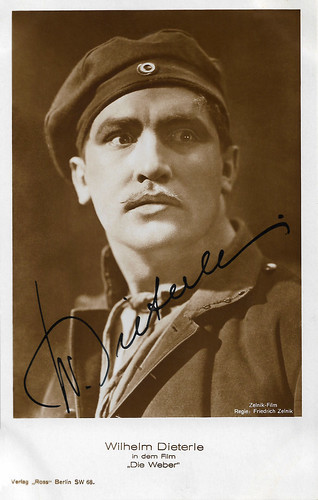
German postcard by Ross Verlag, Berlin. Photo: Zelnik-Film. Wilhelm Dieterle in Die Weber/The Weavers (Friedrich Zelnik, 1927).
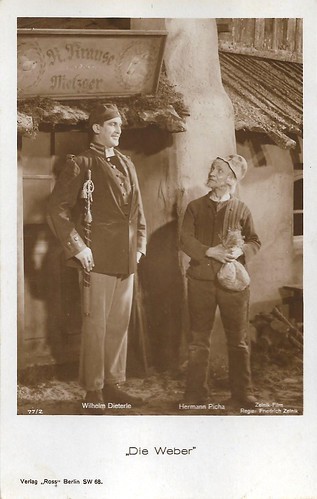
German postcard by Ross Verlag, Berlin, no. 77/2. Photo: Zelnik-Film. Wilhelm Dieterle and Hermann Picha in Die Weber (Friedrich Zelnik, 1927).
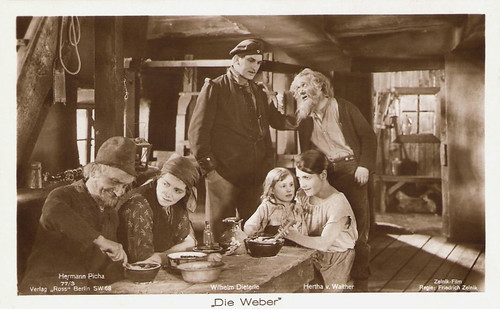
German postcard by Ross Verlag, Berlin, no. 77/3. Photo: Zelnik-Film. Hermann Picha , Wilhelm Dieterle and Hertha von Walther in Die Weber (Friedrich Zelnik, 1927).
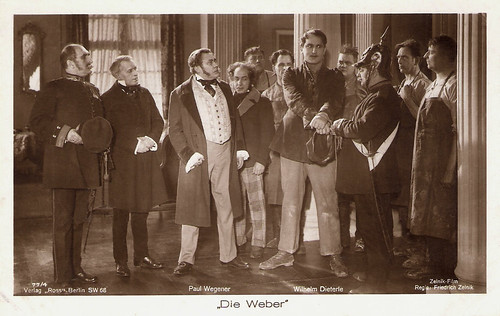
German postcard by Ross Verlag, Berlin, no. 77/4. Photo: Zelnik-Film. Wilhelm Dieterle and Paul Wegener in Die Weber (Friedrich Zelnik, 1927).
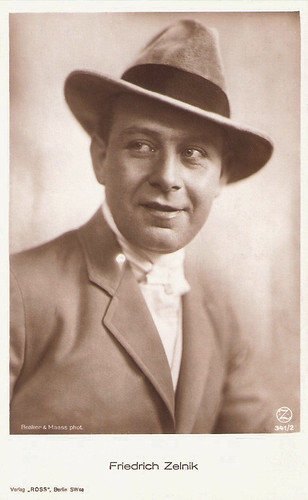
Friedrich Zelnik . German postcard by Ross Verlag, no. 341/2, 1919-1924. Photo: Becker & Maass Phot.
Sources: Wikipedia (German and English), and IMDb.

German postcard by Ross Verlag, Berlin. Photo: Zelnik-Film. Wilhelm Dieterle in Die Weber/The Weavers (Friedrich Zelnik, 1927).

German postcard by Ross Verlag, Berlin, no. 77/2. Photo: Zelnik-Film. Wilhelm Dieterle and Hermann Picha in Die Weber (Friedrich Zelnik, 1927).

German postcard by Ross Verlag, Berlin, no. 77/3. Photo: Zelnik-Film. Hermann Picha , Wilhelm Dieterle and Hertha von Walther in Die Weber (Friedrich Zelnik, 1927).

German postcard by Ross Verlag, Berlin, no. 77/4. Photo: Zelnik-Film. Wilhelm Dieterle and Paul Wegener in Die Weber (Friedrich Zelnik, 1927).

Friedrich Zelnik . German postcard by Ross Verlag, no. 341/2, 1919-1924. Photo: Becker & Maass Phot.
Sources: Wikipedia (German and English), and IMDb.
Published on May 11, 2020 22:00
May 10, 2020
Nadia Gray
Romanian-born actress Nadia Gray (1923-1994) was an elegant and seductive star of European films of the 1950s and 1960s. She is best known for her striptease scene in Fellini’s classic La Dolce Vita (1960).
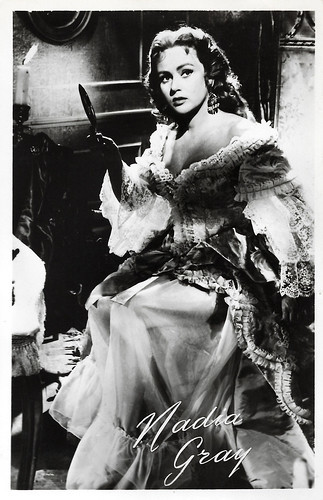
Dutch postcard by Takken, Utrecht, no. 1684. Photo: Nadia Gray in Le avventure di Giacomo Casanova/The Loves of Casanova (Steno, 1955).
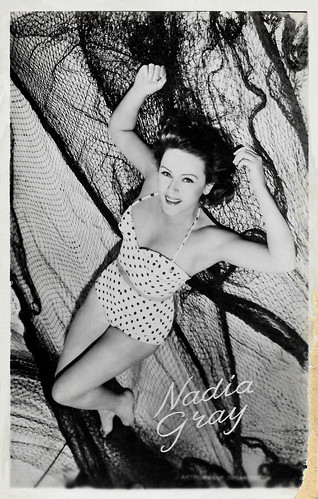
Dutch postcard. Photo: J. Arthur Rank Organisation.
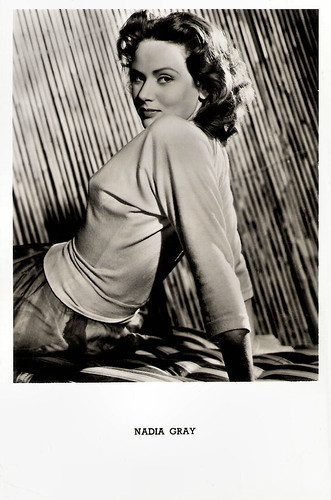
Belgian postcard, no. 271.
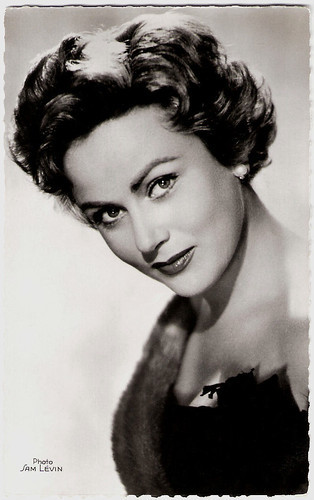
French postcard by Editions du Globe, Paris, no. 346. Photo: Sam Lévin.
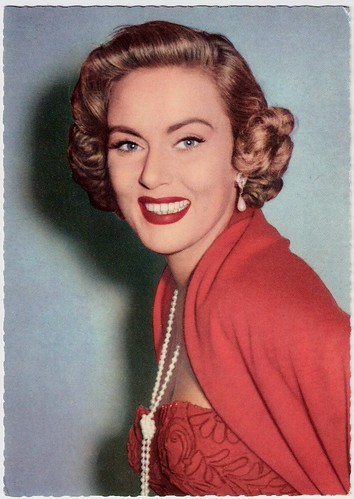
German postcard by ISV, no. M 13. Photo: Europa-Film / Haenchen.
Anarchist Incident
Nadia Gray (sometimes Nadja Grey) was born Nadia Kujnir-Herescu in Bucharest, Romania in 1923. She came from an old Jewish family. Her father was a Russian refugee and her mother was Bessarabian.
As a child, she was such an admirer of King Carol of Romania that she threw down a bunch of flowers from her balcony on the royal cortege passing by. It was a time of anarchist terror and the incident caused her family some trouble.
In 1946, she married the aristocrat Constantin Cantacuzino, a Romanian aviator and WW II fighter ace. They had met when she was a passenger on a commercial air flight at which he was the pilot. One of the engines had caught fire and Cantacuzino was forced to do an emergency landing.
At the time, Gray had just started a career as a theatre actress. In 1947, the couple left Romania for Paris to escape the Communist regime after World War II. Her film debut was in the French-Austrian coproduction L'Inconnu d'un soir/Strangers on a night (Hervé Bromberger, 1948) with Claude Dauphin . She played the leading role as a young waitress who yearns to be a star.
Nadia enjoyed with her husband a cosmopolitan jet-set life and meanwhile, she appeared on stage and in films. Early film roles that led to European stardom included her countess in Monseigneur/Monsignor (Roger Richebe, 1949) opposite Bernard Blier , a woman in love with a master-safecracker (Guy Rolfe) in The Spider and the Fly (Robert Hamer, 1949), and an opera diva in the Technicolor biopic Puccini (Carmine Gallone, 1953) featuring Gabriele Ferzetti as the composer.
Her English language films included the action-adventure Valley of Eagles (Terence Young, 1951), the crime drama Night Without Stars (Anthony Pelissier, 1951) opposite David Farrar , and the comedy The Captain's Table (Jack Lee, 1959). Gray and her husband had eventually settled in Spain, but in 1958 Cantacuzino died.
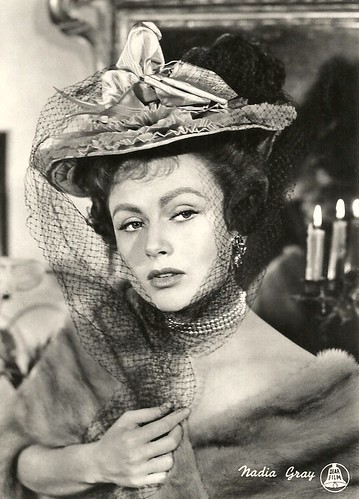
Italian postcard by Bromofoto, Milano. Photo: Dear Film.
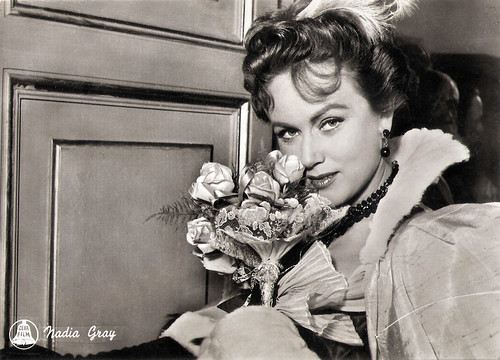
Italian postcard by Bromofoto, Milano, no. 467. Photo: Dear Film.
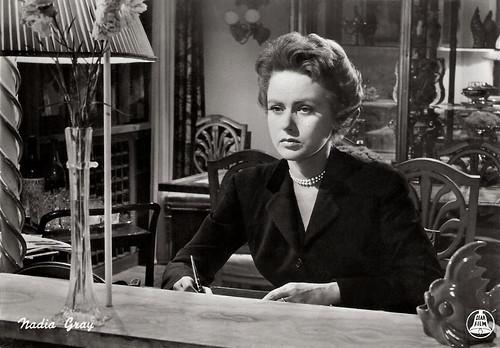
Italian postcard by Bromofoto, Milano, no. 135. Photo: Dear Film. Publicity still for Puccini (Carmine Gallone, 1953).
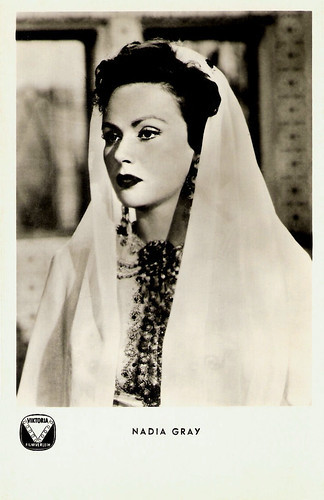
German postcard by Kunst und Bild, Berlin, no. V 301. Photo: Viktoria Filmverleih. Nadia Gray in Ivan (il figlio del diavolo bianco)/Ivan, Son of the White Devil (Guido Brignone, 1953).
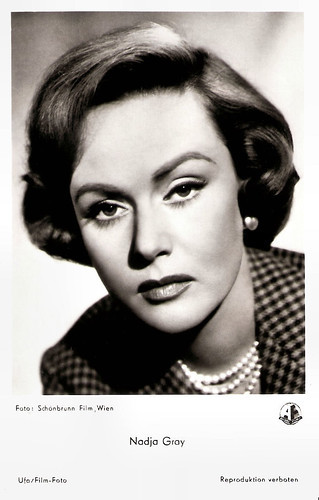
West-German postcard by Ufa/Film-Foto, no. 271. Photo: Schönbrunn-Film, Wien / Allianz Film. Nadia Gray in Hengst Maestoso Austria/Stallion Maestoso Austria (Hermann Kugelstadt, 1956).
Bored and Decadent Socialite
Nadia Gray’s best-known role is as the bored and decadent socialite Nadia in La Dolce Vita (Federico Fellini, 1960) starring Marcello Mastroianni . In fact, her part is only a cameo: toward the end of Fellini's masterpiece, Nadia celebrates her divorce by performing a sensual mink-coated striptease during a wild party at her home.
Gray specialised in aristocratic, jet-set roles. Among her scattered appearances in English-speaking productions were the comedy Mr. Topaze (Peter Sellers, 1961) starring Peter Sellers , the Hammer horror-thriller Maniac (Michael Carreras, 1963) co-starring Kerwin Mathews, the thriller The Naked Runner (Sidney J. Furie, 1967) starring Frank Sinatra , and a supporting role in the classic romance Two for the Road (Stanley Donen, 1967) with Albert Finney and Audrey Hepburn .
On TV, Gray played a.o. Number 8 in The Chimes of Big Ben (1967), an episode of the cult series The Prisoner (1967-1968) starring Patrick McGoohan.
She had acquired the French nationality in 1964, but in 1967 she married Manhattan attorney Herbert Silverman, and they settled in the USA. She retired from films completely in 1976 and began headlining as a nightclub singer.
Nadia Gray died of a stroke in 1994 in New York City. She was 70 and was survived by her second husband and their two stepchildren.
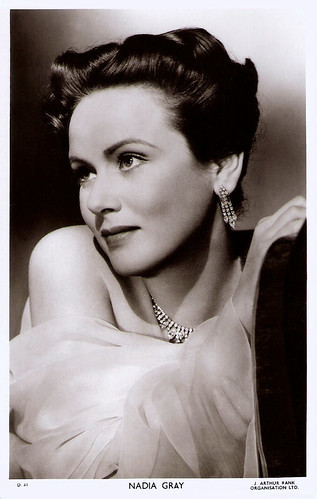
British postcard in the Picturegoer Series, London, no. D 41. Photo: J. Arthur Rank Organisation Ltd.
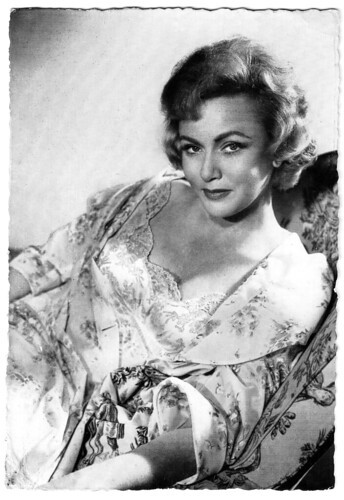
German postcard by WS-Druck, Wanne-Eickel, no. 302. Photo: Bavaria / Cosmopol / Schorcht. Nadia Gray in Meine schöne Mama/My Pretty Mama (Paul Martin, 1958).
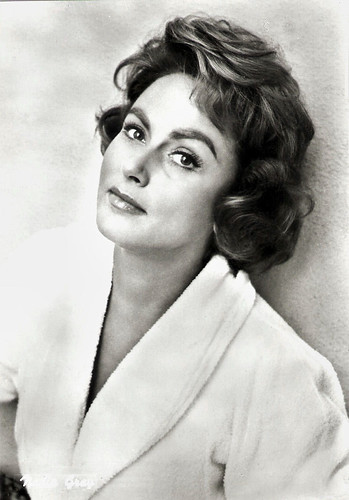
Italian postcard by Bromofoto, Milano, no. 1673. Photo: Rank. Nadia Gray in The Captain's Table (Jack Lee, 1959).
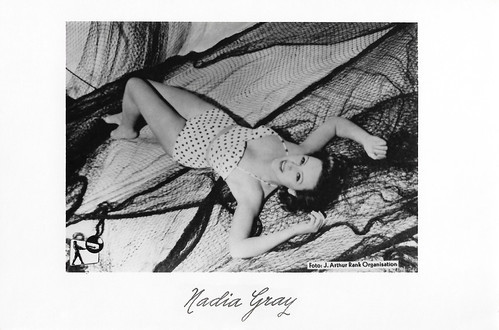
Vintage card. Photo: J. Arthur Rank Organisation Ltd.
A long scene from La Dolce Vita (1960) including the famous striptease (No subtitles - partly in English). Source: Umbgu (YouTube).
Sources: (IMDb), Hal Erickson (AllMovie), Thomas Staedeli (Cyranos), Wikipedia (French, Italian, German and English) and .

Dutch postcard by Takken, Utrecht, no. 1684. Photo: Nadia Gray in Le avventure di Giacomo Casanova/The Loves of Casanova (Steno, 1955).

Dutch postcard. Photo: J. Arthur Rank Organisation.

Belgian postcard, no. 271.

French postcard by Editions du Globe, Paris, no. 346. Photo: Sam Lévin.

German postcard by ISV, no. M 13. Photo: Europa-Film / Haenchen.
Anarchist Incident
Nadia Gray (sometimes Nadja Grey) was born Nadia Kujnir-Herescu in Bucharest, Romania in 1923. She came from an old Jewish family. Her father was a Russian refugee and her mother was Bessarabian.
As a child, she was such an admirer of King Carol of Romania that she threw down a bunch of flowers from her balcony on the royal cortege passing by. It was a time of anarchist terror and the incident caused her family some trouble.
In 1946, she married the aristocrat Constantin Cantacuzino, a Romanian aviator and WW II fighter ace. They had met when she was a passenger on a commercial air flight at which he was the pilot. One of the engines had caught fire and Cantacuzino was forced to do an emergency landing.
At the time, Gray had just started a career as a theatre actress. In 1947, the couple left Romania for Paris to escape the Communist regime after World War II. Her film debut was in the French-Austrian coproduction L'Inconnu d'un soir/Strangers on a night (Hervé Bromberger, 1948) with Claude Dauphin . She played the leading role as a young waitress who yearns to be a star.
Nadia enjoyed with her husband a cosmopolitan jet-set life and meanwhile, she appeared on stage and in films. Early film roles that led to European stardom included her countess in Monseigneur/Monsignor (Roger Richebe, 1949) opposite Bernard Blier , a woman in love with a master-safecracker (Guy Rolfe) in The Spider and the Fly (Robert Hamer, 1949), and an opera diva in the Technicolor biopic Puccini (Carmine Gallone, 1953) featuring Gabriele Ferzetti as the composer.
Her English language films included the action-adventure Valley of Eagles (Terence Young, 1951), the crime drama Night Without Stars (Anthony Pelissier, 1951) opposite David Farrar , and the comedy The Captain's Table (Jack Lee, 1959). Gray and her husband had eventually settled in Spain, but in 1958 Cantacuzino died.

Italian postcard by Bromofoto, Milano. Photo: Dear Film.

Italian postcard by Bromofoto, Milano, no. 467. Photo: Dear Film.

Italian postcard by Bromofoto, Milano, no. 135. Photo: Dear Film. Publicity still for Puccini (Carmine Gallone, 1953).

German postcard by Kunst und Bild, Berlin, no. V 301. Photo: Viktoria Filmverleih. Nadia Gray in Ivan (il figlio del diavolo bianco)/Ivan, Son of the White Devil (Guido Brignone, 1953).

West-German postcard by Ufa/Film-Foto, no. 271. Photo: Schönbrunn-Film, Wien / Allianz Film. Nadia Gray in Hengst Maestoso Austria/Stallion Maestoso Austria (Hermann Kugelstadt, 1956).
Bored and Decadent Socialite
Nadia Gray’s best-known role is as the bored and decadent socialite Nadia in La Dolce Vita (Federico Fellini, 1960) starring Marcello Mastroianni . In fact, her part is only a cameo: toward the end of Fellini's masterpiece, Nadia celebrates her divorce by performing a sensual mink-coated striptease during a wild party at her home.
Gray specialised in aristocratic, jet-set roles. Among her scattered appearances in English-speaking productions were the comedy Mr. Topaze (Peter Sellers, 1961) starring Peter Sellers , the Hammer horror-thriller Maniac (Michael Carreras, 1963) co-starring Kerwin Mathews, the thriller The Naked Runner (Sidney J. Furie, 1967) starring Frank Sinatra , and a supporting role in the classic romance Two for the Road (Stanley Donen, 1967) with Albert Finney and Audrey Hepburn .
On TV, Gray played a.o. Number 8 in The Chimes of Big Ben (1967), an episode of the cult series The Prisoner (1967-1968) starring Patrick McGoohan.
She had acquired the French nationality in 1964, but in 1967 she married Manhattan attorney Herbert Silverman, and they settled in the USA. She retired from films completely in 1976 and began headlining as a nightclub singer.
Nadia Gray died of a stroke in 1994 in New York City. She was 70 and was survived by her second husband and their two stepchildren.

British postcard in the Picturegoer Series, London, no. D 41. Photo: J. Arthur Rank Organisation Ltd.

German postcard by WS-Druck, Wanne-Eickel, no. 302. Photo: Bavaria / Cosmopol / Schorcht. Nadia Gray in Meine schöne Mama/My Pretty Mama (Paul Martin, 1958).

Italian postcard by Bromofoto, Milano, no. 1673. Photo: Rank. Nadia Gray in The Captain's Table (Jack Lee, 1959).

Vintage card. Photo: J. Arthur Rank Organisation Ltd.
A long scene from La Dolce Vita (1960) including the famous striptease (No subtitles - partly in English). Source: Umbgu (YouTube).
Sources: (IMDb), Hal Erickson (AllMovie), Thomas Staedeli (Cyranos), Wikipedia (French, Italian, German and English) and .
Published on May 10, 2020 22:00
May 9, 2020
R.I.P.: Little Richard (1932-2020)
Yesterday, 9 May 2020, American pianist-singer Little Richard passed away. In the mid-1950s, his dynamic songs like 'Tutti Frutti' and 'Good Golly Miss Molly' and his charismatic showmanship laid the foundation for rock and roll. He was one of the first crossover black artists, reaching audiences of all races. Little Richard was 87.
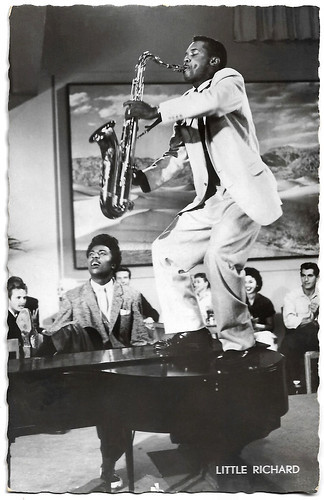
Dutch postcard by Uitg. Int. Filmpers (I.F.P.), Amsterdam, no. 1525. Little Richard performs with his band as his saxophone player Grady Gaines stands on the piano in Mister Rock And Roll (Charles S. Dubin, 1957).
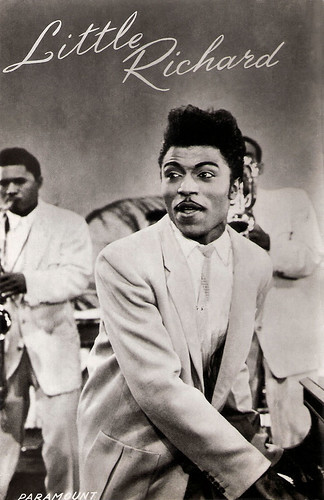
Dutch postcard by Uitg. Takken, Utrecht, no. 3384. Photo: Paramount. Little Richard in Mister Rock and Roll (Charles S. Dubin, 1957).
The Girl Can't Help It
Little Richard was born as Richard Wayne Penniman in 1932 in Macon, Georgia, USA. His mother was Leva Mae Penniman, and his father was Charles "Bud" Penniman, a church deacon and a brick mason, who sold bootlegged moonshine on the side and owned a nightclub called the Tip In Inn. Richard was the third born child and had five sisters and six brothers.
Before entering the tenth grade, Penniman left his family home and joined Dr. Hudson's Medicine Show in 1949. His first recording session took place at WGST in Atlanta, Georgia. He was backed by a local band led by Billy Wright. This session produced a local hit called 'Every Hour'. Little Richard admitted to copying Wright's penchant for heavy makeup and wild stage theatrics.
With a public persona and personal life marked by sexual ambiguity, he would make his mark with later hits such as the suggestive 'Tutti Frutti' and 'Good Golly Miss Molly'. 'Tutti Frutti' (1955) became an instant hit, reaching no. 2 on Billboard magazine's Rhythm and Blues Best-Sellers chart and crossing over to the pop charts in both the United States and in Europe.
Richard's next hit single, 'Long Tall Sally' (1956), hit no. 1 on the Billboard Rhythm and Blues Best-Sellers chart. Like 'Tutti Frutti', it sold over a million copies. Overall, he would produce seven singles in the U.S. in 1956, including 'The Girl Can't Help It' and 'Lucille'. His performances during this period resulted in integration between whites and blacks in his audience.
He also appeared in such films as Don't Knock the Rock (Fred W. Sears, 1956) with Bill Haley, The Girl Can't Help It (Frank Tashlin, 1956) starring Jayne Mansfield , and Mister Rock And Roll (Charles S. Dubin, 1957).
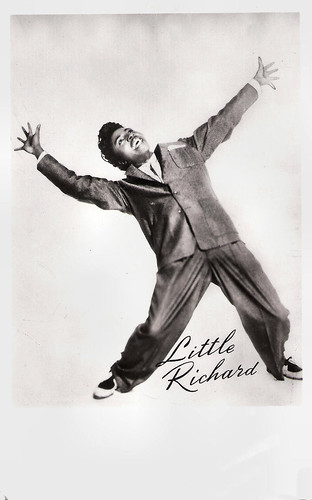
Dutch postcard by Uitg. Takken, Utrecht, no. 1995.
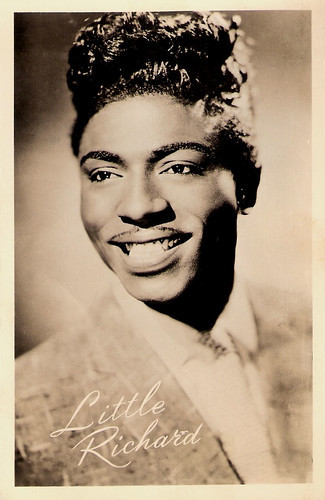
Dutch postcard by Uitg. Takken, Utrecht, no. 1996.
Held up by angels
In October 1957, Little Richard embarked on a package tour in Australia with Gene Vincent and Eddie Cochran. In his autobiography, he later wrote that during a flight from Melbourne to Sydney that his plane was experiencing some difficulty and he saw the plane's red hot engines and felt angels were "holding it up". At the end of his Sydney performance, Little Richard saw a bright red fireball flying across the sky above him and claimed he was "deeply shaken". He took it as a "sign from God" to repent from performing secular music and his wild lifestyle at the time.
Returning to the States ten days earlier than expected, he read news of his original flight having crashed into the Pacific Ocean as a further sign to "do as God wanted". After a "farewell performance" at the Apollo Theater and a "final" recording session with the Specialty label later that month, Richard Penniman enrolled at Oakwood College in Huntsville, Alabama, to study theology.
A month after his conversion, Penniman met Ernestine Harvin, a secretary from Washington, D.C., and the couple married in 1959. He ventured into gospel music, first recording for End Records, before signing with Mercury Records in 1961, where he eventually released 'King of the Gospel Singers', in 1962, produced by Quincy Jones, who later remarked that Penniman's vocals impressed him more than any other vocalist he had worked with.
In 1962, during a five-year period in which Little Richard abandoned rock and roll for born again Christianity, concert promoter Don Arden persuaded him to tour Europe. During this time, Arden had The Beatles open for Penniman on some tour dates. David Browne at Rolling Stone : "Although he never hit the Top 10 again after 1958, Little Richard’s influence was massive. The Beatles recorded several of his songs, including 'Long Tall Sally,' and Paul McCartney ’s singing on those tracks – and the Beatles’ own 'I’m Down' – paid tribute to Little Richard’s shredded-throat style. His songs became part of the rock & roll canon, covered over the decades by everyone from the Everly Brothers, the Kinks, and Creedence Clearwater Revival to Elvis Costello and the Scorpions. "
Little Richard overcame a debilitating drug habit and eventually became an ordained minister. Beginning in the 1980s, he saw a resurgence in his popularity as he acquired small acting roles in such films as Down and Out in Beverly Hills (Paul Mazursky, 1986) in which he showed his comedic timing. As versatile and ageless as ever, Little Richard continued to delight fans the world over with his stage presence and flamboyant antics.
He was inducted into the Rock and Roll Hall of Fame and the American Songwriters Hall of Fame. From 1959 till 1963, he was married to Ernestine Campbell, with whom he had a son, Danny Penniman. Little Richard passed away in Nashville, Tennessee, aged 87. The cause of death was bone cancer.
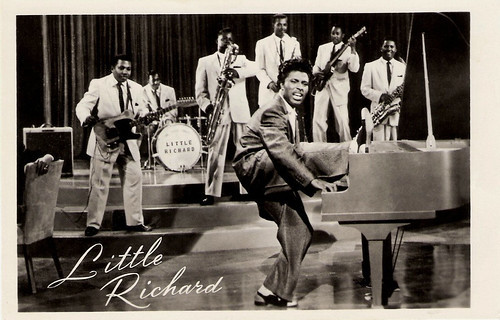
Dutch postcard by Takken, no. 2043. Little Richard in The Girl Can't Help It (Frank Tashlin, 1956).
Scenes from The Girl Can't Help It (Frank Tashlin, 1956) with Little Richard's recording of the title song. Source: SuperCanopus (YouTube).
Source: David Browne (Rolling Stone), Wikipedia, and .

Dutch postcard by Uitg. Int. Filmpers (I.F.P.), Amsterdam, no. 1525. Little Richard performs with his band as his saxophone player Grady Gaines stands on the piano in Mister Rock And Roll (Charles S. Dubin, 1957).

Dutch postcard by Uitg. Takken, Utrecht, no. 3384. Photo: Paramount. Little Richard in Mister Rock and Roll (Charles S. Dubin, 1957).
The Girl Can't Help It
Little Richard was born as Richard Wayne Penniman in 1932 in Macon, Georgia, USA. His mother was Leva Mae Penniman, and his father was Charles "Bud" Penniman, a church deacon and a brick mason, who sold bootlegged moonshine on the side and owned a nightclub called the Tip In Inn. Richard was the third born child and had five sisters and six brothers.
Before entering the tenth grade, Penniman left his family home and joined Dr. Hudson's Medicine Show in 1949. His first recording session took place at WGST in Atlanta, Georgia. He was backed by a local band led by Billy Wright. This session produced a local hit called 'Every Hour'. Little Richard admitted to copying Wright's penchant for heavy makeup and wild stage theatrics.
With a public persona and personal life marked by sexual ambiguity, he would make his mark with later hits such as the suggestive 'Tutti Frutti' and 'Good Golly Miss Molly'. 'Tutti Frutti' (1955) became an instant hit, reaching no. 2 on Billboard magazine's Rhythm and Blues Best-Sellers chart and crossing over to the pop charts in both the United States and in Europe.
Richard's next hit single, 'Long Tall Sally' (1956), hit no. 1 on the Billboard Rhythm and Blues Best-Sellers chart. Like 'Tutti Frutti', it sold over a million copies. Overall, he would produce seven singles in the U.S. in 1956, including 'The Girl Can't Help It' and 'Lucille'. His performances during this period resulted in integration between whites and blacks in his audience.
He also appeared in such films as Don't Knock the Rock (Fred W. Sears, 1956) with Bill Haley, The Girl Can't Help It (Frank Tashlin, 1956) starring Jayne Mansfield , and Mister Rock And Roll (Charles S. Dubin, 1957).

Dutch postcard by Uitg. Takken, Utrecht, no. 1995.

Dutch postcard by Uitg. Takken, Utrecht, no. 1996.
Held up by angels
In October 1957, Little Richard embarked on a package tour in Australia with Gene Vincent and Eddie Cochran. In his autobiography, he later wrote that during a flight from Melbourne to Sydney that his plane was experiencing some difficulty and he saw the plane's red hot engines and felt angels were "holding it up". At the end of his Sydney performance, Little Richard saw a bright red fireball flying across the sky above him and claimed he was "deeply shaken". He took it as a "sign from God" to repent from performing secular music and his wild lifestyle at the time.
Returning to the States ten days earlier than expected, he read news of his original flight having crashed into the Pacific Ocean as a further sign to "do as God wanted". After a "farewell performance" at the Apollo Theater and a "final" recording session with the Specialty label later that month, Richard Penniman enrolled at Oakwood College in Huntsville, Alabama, to study theology.
A month after his conversion, Penniman met Ernestine Harvin, a secretary from Washington, D.C., and the couple married in 1959. He ventured into gospel music, first recording for End Records, before signing with Mercury Records in 1961, where he eventually released 'King of the Gospel Singers', in 1962, produced by Quincy Jones, who later remarked that Penniman's vocals impressed him more than any other vocalist he had worked with.
In 1962, during a five-year period in which Little Richard abandoned rock and roll for born again Christianity, concert promoter Don Arden persuaded him to tour Europe. During this time, Arden had The Beatles open for Penniman on some tour dates. David Browne at Rolling Stone : "Although he never hit the Top 10 again after 1958, Little Richard’s influence was massive. The Beatles recorded several of his songs, including 'Long Tall Sally,' and Paul McCartney ’s singing on those tracks – and the Beatles’ own 'I’m Down' – paid tribute to Little Richard’s shredded-throat style. His songs became part of the rock & roll canon, covered over the decades by everyone from the Everly Brothers, the Kinks, and Creedence Clearwater Revival to Elvis Costello and the Scorpions. "
Little Richard overcame a debilitating drug habit and eventually became an ordained minister. Beginning in the 1980s, he saw a resurgence in his popularity as he acquired small acting roles in such films as Down and Out in Beverly Hills (Paul Mazursky, 1986) in which he showed his comedic timing. As versatile and ageless as ever, Little Richard continued to delight fans the world over with his stage presence and flamboyant antics.
He was inducted into the Rock and Roll Hall of Fame and the American Songwriters Hall of Fame. From 1959 till 1963, he was married to Ernestine Campbell, with whom he had a son, Danny Penniman. Little Richard passed away in Nashville, Tennessee, aged 87. The cause of death was bone cancer.

Dutch postcard by Takken, no. 2043. Little Richard in The Girl Can't Help It (Frank Tashlin, 1956).
Scenes from The Girl Can't Help It (Frank Tashlin, 1956) with Little Richard's recording of the title song. Source: SuperCanopus (YouTube).
Source: David Browne (Rolling Stone), Wikipedia, and .
Published on May 09, 2020 22:00
May 8, 2020
Male stars of the Comédie-Française
Last Saturday, EFSP had a post on a postcard series with the stars of the Comédie-Française by the French publisher FA (F.A. Christensen). Ivo Blom acquired also another fantastic postcard series with male Comédie-Française stars. Today, we present this series published by a company called PMM and the photos were made by Boyer. Ivo thinks the date of the portraits must be between 1890 and 1910. Soon, another post will follow here with a series of coloured postcards of Comédie-Française vedettes.

French postcard by PMM. Photo: Boyer, Paris.
Pierre Laugier (1864-1907) was an actor of the Comédie-Française from 1885, becoming sociétaire in 1894. Memorable parts he had in 'Tartuffe' (as Orgon), 'L'Avare' by Molière, 'Les Folies amoureuses (ás Albert) by Jean-François Regnard, 'Le Gendre de M. Poirier' by Emile Augier et Jules Sandeau, 'Il ne faut jurer de rien' by Alfred de Musset, and 'Thermidor' by Victorien Sardou. He died, aged just 42, from scarlet fever at the bedside of one of his two daughters. He was the grand-nephew of François Arago. As far as known he didn't act in films.
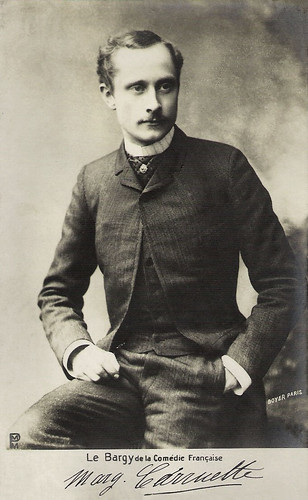
French postcard by PMM. Photo: Boyer, Paris.
Charles Le Bargy (1858-1936) was already a famous stage actor in his time, performing at the Comedie-Française when he debuted in the cinema as the perfidious King Henry III in L'Assassinat du Duc de Guise/The Assassination of the Duke de Guise (André Calmettes, Charles Le Bargy, 1908).
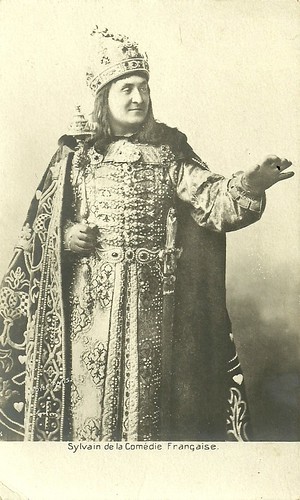
French postcard by PMM.
Eugène Silvain (1851-1930), better known as Sylvain and Silvain, was a prominent French stage actor, though he is best remembered as the evil bishop Cauchon in Carl Theodor Dreyer’s silent masterpiece La passion de Jeanne d’Arc/The Passion of Joan of Arc (1928).
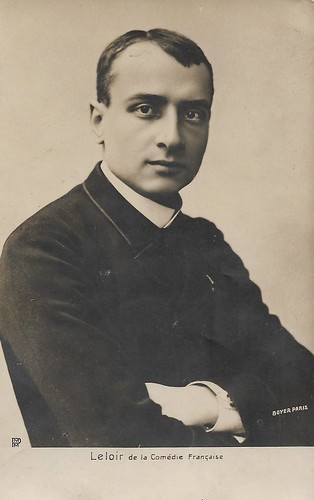
French postcard by PMM. Photo: Boyer, Paris.
Louis Leloir (1860-1909), aka Leloir and originally Louis Pierre Sallot, was a French actor, and a Sociétaire of the Comédie-Française between 1889 and 1909. Parallel to his stage career, he was appointed as a teacher at the Conservatoire de musique et déclamation in 1894, and as the vice-president of the Société des artistes dramatiques in 1897. Because of his courageous behaviour during the 1900 fire at the Comédie-Française, he was awarded the Légion d'Honneur the same year. When he died in 1909, he was a board member of the Comédie-Française and one of its regular stage directors.
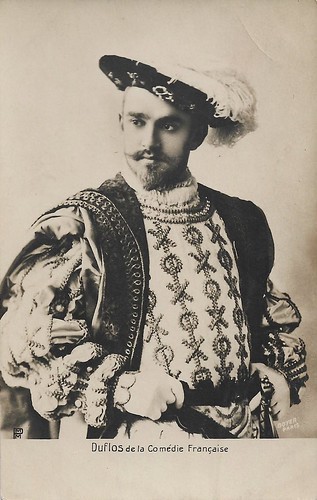
French postcard by PMM. Photo: Boyer, Paris. The costume could refer to Victor Hugo's 'Hernani', in which Duflos played Don Carlos, the future Charles V.
Raphaël Duflos (1858-1946) was a French famous Comédie-Française stage actor, who also acted in a handful of French silent films. He joined the Paris Comédie-Française in 1884. Between 1883 and 1898 he also acted outside of the Comédie, in the 1890s often at the Théâtre du Gymnase. He was Sociétaire at the Comédie-Française between 1896 and 1924 (as the 331st member) and became an honorary member in 1925. He also taught at the National Conservatory of Dramatic Art, where he had among his pupils Huguette Duflos . They married in 1910 but divorced in 1928.

French postcard by PMM. Photo: Boyer, Paris.
Jules Truffier (1856-1943) was a respected actor of the Comédie-Française. Truffier jr. entered the Comédie-Française in 1875, became a Sociétaire there in 1888, retired in 1913, and in 1922 became Sociétaire Honoraire. All in all, he played some 150 parts in an almost 40 years time span. In 1914 he quit acting in 'Maître Favilla', an adaptation by himself of a piece by George Sand, and in the same year became the manager of the Études classiques de la Comédie-Française, so the staging of the classic repertory by the Comédie. This he did until 1918/1919. As far as known, he didn't act in a film, but between 1906 and 1929, he was a teacher at the Conservatoire and trained future screen actors such as Berthe Bovy , Pierre Dux, and Pierre Blanchar .
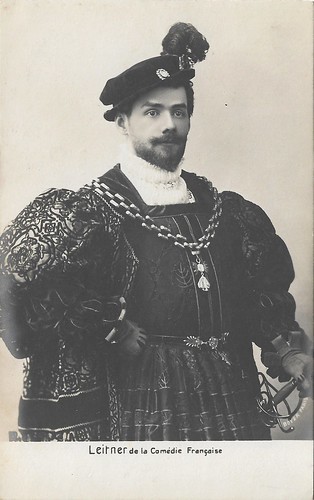
French postcard. Photo: Boyer, Paris. Jules Leitner is dressed as Charles V (Don Carlos) in Victor Hugo's 'Hernani'. He played this tole first in 1906.
Jules-Louis-Auguste Leitner (1862-1940) was a French stage actor of the Comédie-Française. As a student at the National Conservatory of Declamation in Paris, Leitner won a First Prize in Tragedy and a First Prize in Comedy. He entered the Comédie-Française in 1887 and was appointed as a Sociétaire (the 330th) in 1896, which he continued to be until 1919. Leitner was also a teacher at the Paris Conservatory and saw his young pupil Élie Calvé (1904-1929) die on stage in 1929 after the latter had just learned that he had won the 1st Prize for Comedy. Leitner acted in a few Film d'Art productions including Jésus de Nazareth/Jesus of Nazareth (André Calmettes, Henri Desfontaines, 1911).
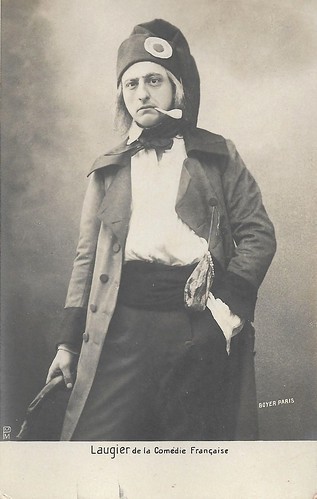
French postcard. Photo Boyer, Paris. Pierre Laugier's outfit may refer to Victorien Sardou's play 'Thermidor', in which Laugier played Marteau, first in 1891.
Pierre Laugier (1864-1907) was an actor of the Comédie-Française from 1885, becoming a Sociétaire in 1894. He had memorable parts in 'Tartuffe' (as Orgon), 'L'Avare' by Molière, 'Les Folies amoureuses' (as Albert) by Jean-François Regnard, 'Le Gendre de M. Poirier' by Emile Augier and Jules Sandeau, 'Il ne faut jurer de rien' by Alfred de Musset, and 'Thermidor' by Victorien Sardou. He died, aged just 42, from scarlet fever at the bedside of one of his two daughters. He was the grand-nephew of François Arago. As far as known, he didn't act in films.
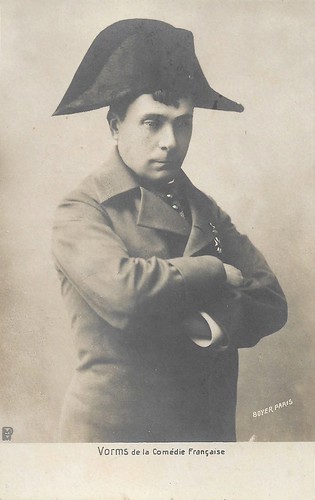
French postcard by PMM. Photo: Boyer, Paris.
Gustave Worms (1836-1910) was a French stage actor of the Comédie-Française. He entered the company in 1858 and was appointed as a Sociétaire in 1878. In 1900 he left the Comédie. Gustave Worms was the father of stage and screen actor Jean Worms. Marguerite Moreno , Édouard de Max, and Lugné-Poe were among his pupils at the Conservatoire, the Parisian drama school. As far as is known, Worms didn't act in a film, while his son was a prolific film actor from the 1910s onward.
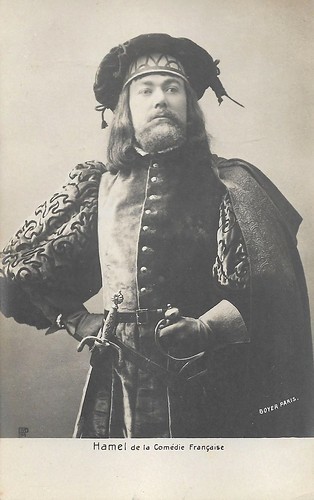
French postcard by PMM. Photo: Boyer, Paris.
Augustin-Julien Hamel was active at the Comédie-Française in 1882 and between 1884 and 1910.
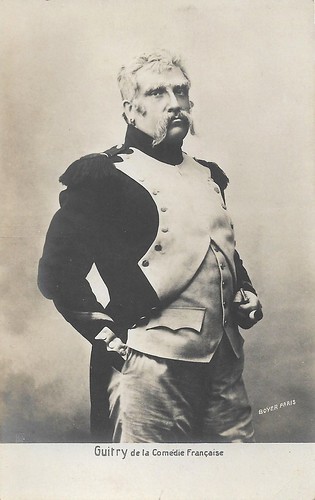
French postcard by PMM. Photo: Boyer, Paris. Lucien Guitry as Flambeau in 'L'Aiglon' (1900) by Edmond Rostand.
Lucien Guitry (1860-1925) was considered the preeminent French actor of his day. For many years, he played opposite Sarah Bernhardt . He also appeared in silent films like Tosca (André Calmettes, 1908) and Ceux de chez nous/Those of Our Land (Sacha Guitry, Frederic Rossif, 1915). He was married to Jeanne Desclois and Renée de Pont-Jest, and his son was the well-known actor-writer-director Sacha Guitry .
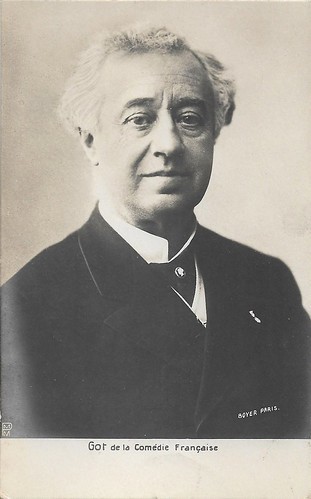
French postcard by PMM. Photo: Boyer, Paris.
Edmond Got (1822-1901) was a French stage actor of the Comédie-Française. He entered the company in 1844 and was appointed as a Sociétaire in 1850, and as a Doyen between 1873 and 1894. In 1894 he left the Comédie. In the mid-19th century, he was one of the most respected stage actors, beloved for his grand style.
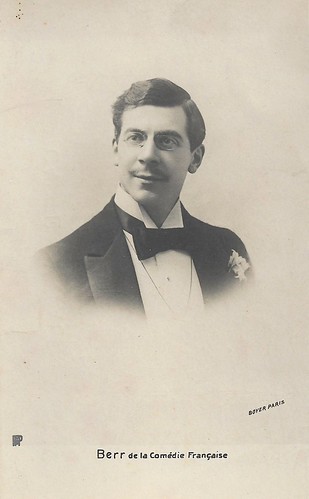
French postcard by PMM. Photo: Boyer, Paris.
Georges Berr (1867-1942) in Paris, was a French actor and dramatist, a member and Sociétaire of the Comédie-Française from 1886 to 1923. Under the pseudonyms Colias and Henry Bott, he wrote several plays, particularly in collaboration with Louis Verneuil. He was Jean-Pierre Aumont 's uncle. He acted in only one film, the Molière adaptation Les précieuses ridicules/The Affected Ladies (1910), directed by himself, and he directed one other film, L'enfant prodigue/The Prodigal Son (1909), both for Pathé Frères. However, Berr was a most active playwright whose plays were often adapted for the cinema, such as Le Million/The Million (1931), filmed by René Clair, and scripted by Clair and Berr himself. Berr worked on three other film scenarios, while he was the dialogue writer for four more films, including La porteuse de pain/The Bread Peddler (René Sti, 1934).
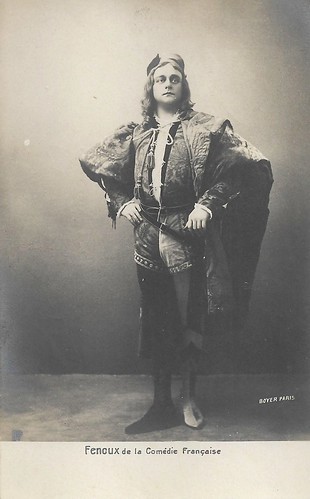
French postcard by PMM. Photo Boyer, Paris.
Jacques Fenoux (1870-1930) entered the Comédie-Française in 1895, became a Sociétaire in 1906, retired in 1924, and became a Sociétaire honoraire in 1925. As the site of the Comédie states: "Fenoux was the type of a conscientious member, able to move effortlessly from one job to another, from small to large parts. He was appointed an honorary member in 1925 but continued to play until his last days. He barely disappeared two weeks after having last interpreted Bazile, from 'The Barber of Seville'." As far is known, his only performance was in Jacques de Féraudy's film Molière, sa vie, son oeuvre/Molière, his life, his work (1922), in which actors of the Comédie-Française can be seen rehearsing plays by Molière.
Sources: Comédie-Française (French), Fondation Jérome Seydoux, Filmographie Le Film d'Art by Eric Le Roy, Wikipedia (English and French), and .

French postcard by PMM. Photo: Boyer, Paris.
Pierre Laugier (1864-1907) was an actor of the Comédie-Française from 1885, becoming sociétaire in 1894. Memorable parts he had in 'Tartuffe' (as Orgon), 'L'Avare' by Molière, 'Les Folies amoureuses (ás Albert) by Jean-François Regnard, 'Le Gendre de M. Poirier' by Emile Augier et Jules Sandeau, 'Il ne faut jurer de rien' by Alfred de Musset, and 'Thermidor' by Victorien Sardou. He died, aged just 42, from scarlet fever at the bedside of one of his two daughters. He was the grand-nephew of François Arago. As far as known he didn't act in films.

French postcard by PMM. Photo: Boyer, Paris.
Charles Le Bargy (1858-1936) was already a famous stage actor in his time, performing at the Comedie-Française when he debuted in the cinema as the perfidious King Henry III in L'Assassinat du Duc de Guise/The Assassination of the Duke de Guise (André Calmettes, Charles Le Bargy, 1908).

French postcard by PMM.
Eugène Silvain (1851-1930), better known as Sylvain and Silvain, was a prominent French stage actor, though he is best remembered as the evil bishop Cauchon in Carl Theodor Dreyer’s silent masterpiece La passion de Jeanne d’Arc/The Passion of Joan of Arc (1928).

French postcard by PMM. Photo: Boyer, Paris.
Louis Leloir (1860-1909), aka Leloir and originally Louis Pierre Sallot, was a French actor, and a Sociétaire of the Comédie-Française between 1889 and 1909. Parallel to his stage career, he was appointed as a teacher at the Conservatoire de musique et déclamation in 1894, and as the vice-president of the Société des artistes dramatiques in 1897. Because of his courageous behaviour during the 1900 fire at the Comédie-Française, he was awarded the Légion d'Honneur the same year. When he died in 1909, he was a board member of the Comédie-Française and one of its regular stage directors.

French postcard by PMM. Photo: Boyer, Paris. The costume could refer to Victor Hugo's 'Hernani', in which Duflos played Don Carlos, the future Charles V.
Raphaël Duflos (1858-1946) was a French famous Comédie-Française stage actor, who also acted in a handful of French silent films. He joined the Paris Comédie-Française in 1884. Between 1883 and 1898 he also acted outside of the Comédie, in the 1890s often at the Théâtre du Gymnase. He was Sociétaire at the Comédie-Française between 1896 and 1924 (as the 331st member) and became an honorary member in 1925. He also taught at the National Conservatory of Dramatic Art, where he had among his pupils Huguette Duflos . They married in 1910 but divorced in 1928.

French postcard by PMM. Photo: Boyer, Paris.
Jules Truffier (1856-1943) was a respected actor of the Comédie-Française. Truffier jr. entered the Comédie-Française in 1875, became a Sociétaire there in 1888, retired in 1913, and in 1922 became Sociétaire Honoraire. All in all, he played some 150 parts in an almost 40 years time span. In 1914 he quit acting in 'Maître Favilla', an adaptation by himself of a piece by George Sand, and in the same year became the manager of the Études classiques de la Comédie-Française, so the staging of the classic repertory by the Comédie. This he did until 1918/1919. As far as known, he didn't act in a film, but between 1906 and 1929, he was a teacher at the Conservatoire and trained future screen actors such as Berthe Bovy , Pierre Dux, and Pierre Blanchar .

French postcard. Photo: Boyer, Paris. Jules Leitner is dressed as Charles V (Don Carlos) in Victor Hugo's 'Hernani'. He played this tole first in 1906.
Jules-Louis-Auguste Leitner (1862-1940) was a French stage actor of the Comédie-Française. As a student at the National Conservatory of Declamation in Paris, Leitner won a First Prize in Tragedy and a First Prize in Comedy. He entered the Comédie-Française in 1887 and was appointed as a Sociétaire (the 330th) in 1896, which he continued to be until 1919. Leitner was also a teacher at the Paris Conservatory and saw his young pupil Élie Calvé (1904-1929) die on stage in 1929 after the latter had just learned that he had won the 1st Prize for Comedy. Leitner acted in a few Film d'Art productions including Jésus de Nazareth/Jesus of Nazareth (André Calmettes, Henri Desfontaines, 1911).

French postcard. Photo Boyer, Paris. Pierre Laugier's outfit may refer to Victorien Sardou's play 'Thermidor', in which Laugier played Marteau, first in 1891.
Pierre Laugier (1864-1907) was an actor of the Comédie-Française from 1885, becoming a Sociétaire in 1894. He had memorable parts in 'Tartuffe' (as Orgon), 'L'Avare' by Molière, 'Les Folies amoureuses' (as Albert) by Jean-François Regnard, 'Le Gendre de M. Poirier' by Emile Augier and Jules Sandeau, 'Il ne faut jurer de rien' by Alfred de Musset, and 'Thermidor' by Victorien Sardou. He died, aged just 42, from scarlet fever at the bedside of one of his two daughters. He was the grand-nephew of François Arago. As far as known, he didn't act in films.

French postcard by PMM. Photo: Boyer, Paris.
Gustave Worms (1836-1910) was a French stage actor of the Comédie-Française. He entered the company in 1858 and was appointed as a Sociétaire in 1878. In 1900 he left the Comédie. Gustave Worms was the father of stage and screen actor Jean Worms. Marguerite Moreno , Édouard de Max, and Lugné-Poe were among his pupils at the Conservatoire, the Parisian drama school. As far as is known, Worms didn't act in a film, while his son was a prolific film actor from the 1910s onward.

French postcard by PMM. Photo: Boyer, Paris.
Augustin-Julien Hamel was active at the Comédie-Française in 1882 and between 1884 and 1910.

French postcard by PMM. Photo: Boyer, Paris. Lucien Guitry as Flambeau in 'L'Aiglon' (1900) by Edmond Rostand.
Lucien Guitry (1860-1925) was considered the preeminent French actor of his day. For many years, he played opposite Sarah Bernhardt . He also appeared in silent films like Tosca (André Calmettes, 1908) and Ceux de chez nous/Those of Our Land (Sacha Guitry, Frederic Rossif, 1915). He was married to Jeanne Desclois and Renée de Pont-Jest, and his son was the well-known actor-writer-director Sacha Guitry .

French postcard by PMM. Photo: Boyer, Paris.
Edmond Got (1822-1901) was a French stage actor of the Comédie-Française. He entered the company in 1844 and was appointed as a Sociétaire in 1850, and as a Doyen between 1873 and 1894. In 1894 he left the Comédie. In the mid-19th century, he was one of the most respected stage actors, beloved for his grand style.

French postcard by PMM. Photo: Boyer, Paris.
Georges Berr (1867-1942) in Paris, was a French actor and dramatist, a member and Sociétaire of the Comédie-Française from 1886 to 1923. Under the pseudonyms Colias and Henry Bott, he wrote several plays, particularly in collaboration with Louis Verneuil. He was Jean-Pierre Aumont 's uncle. He acted in only one film, the Molière adaptation Les précieuses ridicules/The Affected Ladies (1910), directed by himself, and he directed one other film, L'enfant prodigue/The Prodigal Son (1909), both for Pathé Frères. However, Berr was a most active playwright whose plays were often adapted for the cinema, such as Le Million/The Million (1931), filmed by René Clair, and scripted by Clair and Berr himself. Berr worked on three other film scenarios, while he was the dialogue writer for four more films, including La porteuse de pain/The Bread Peddler (René Sti, 1934).

French postcard by PMM. Photo Boyer, Paris.
Jacques Fenoux (1870-1930) entered the Comédie-Française in 1895, became a Sociétaire in 1906, retired in 1924, and became a Sociétaire honoraire in 1925. As the site of the Comédie states: "Fenoux was the type of a conscientious member, able to move effortlessly from one job to another, from small to large parts. He was appointed an honorary member in 1925 but continued to play until his last days. He barely disappeared two weeks after having last interpreted Bazile, from 'The Barber of Seville'." As far is known, his only performance was in Jacques de Féraudy's film Molière, sa vie, son oeuvre/Molière, his life, his work (1922), in which actors of the Comédie-Française can be seen rehearsing plays by Molière.
Sources: Comédie-Française (French), Fondation Jérome Seydoux, Filmographie Le Film d'Art by Eric Le Roy, Wikipedia (English and French), and .
Published on May 08, 2020 22:00
May 7, 2020
Tilda Thamar
Actress Tilda Thamar (1917–1989) became known as the ‘Blonde Bombshell from Argentina’ in the French cinema of the 1950s. After Eva Perón had ruled that there was no further filming in Argentina, Thamar left for Europe. She continued to make films in France till her death in a car accident.
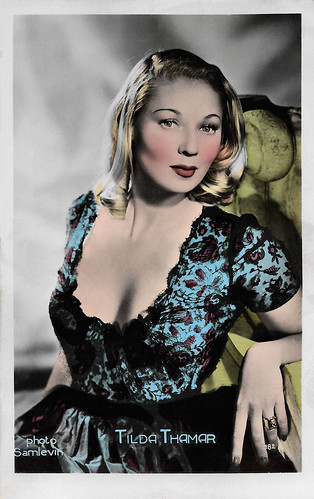
French postcard by Editions P.I., Paris, no. 182. Photo: Sam Levin.
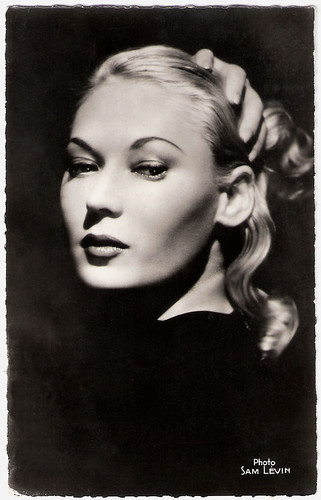
French postcard by Editions du Globe, Paris, no. 149. Photo: Sam Lévin.
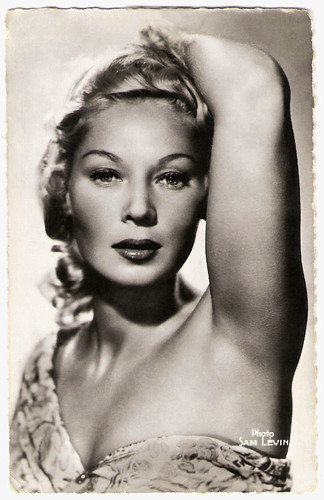
French postcard by Editions du Globe, Paris, no. 192. Photo: Sam Lévin.
Sculptural Silhouette and blond hair
Tilda Thamar was born Matilda Sofia Abrecht de Vidal Quadras in Urdinarrain, Argentina in 1917 (some sources say 1921). She was the daughter of the German immigrants Martha Nichoerster and Carlos Abrecht. Her father worked as a bookseller and teacher in the German language. In 1925 he opened a book, record and jewelry shop annex photo studio.
Tilda started her career as a teenager with bit roles in Argentine films, such as Don Quijote del altillo/Don Quixote in the attic (Manuel Romero, 1936). She took her stage name from transposing the syllables of the name of her mother Martha (tha-mar). In Segundos afuera!/Seconds out! (Israel Chas de Cruz, Alberto Etchebehere, 1937) starred the boxer Pedrito Quartucci. Eva Duarte (the later Evita Perón) played a small part in it.
The following years Thamar appeared as an extra or bit player in several Argentine films, including El Loco Serenata/The crazy musician (Luis Saslavsky, 1939) with Pepe Arias, Ceniza al viento/Ashes to the wind (Luis Saslavsky, 1941) with Tita Merello, and El espejo/The mirror (Francisco Mugica, 1943) starring Mirtha Legrand.
Her roles got bigger in such popular films as El muerto falta a la cita/The corpse breaks a date (Pierre Chenal, 1944), the comedy La casta Susana/Chaste Susan (Benito Perojo, 1944) based on a German operetta with music by Jean Gilbert, and La señora de Pérez se divorcia/Mrs. Perez and her divorce (Carlos Hugo Christensen, 1945) featuring Mirtha Legrand.
Tilda became increasingly popular thanks to her talent but also to her sculptural silhouette and blond hair. One of her most successful films was Adán y la serpiente/Adam and the Serpent (Carlos Hugo Christensen, 1946), which was the first Argentine film forbidden for minors under 18. Thamar wore a bikini in the film and she was the first Argentine woman who dared to do so.
According to Spanish Wikipedia , she appeared in these Argentine films of the 1940s “not as a femme fatale but as a rogue vampire, who got into the lives of men, gave them a moment of solace and then draw the attention of their unsuspecting wives.”
In 1947, Thamar was offered an attractive contract by the Lumiton studio to make film seven films as their main star. But after only one film, Novio, marido y amante/Boyfriend, husband and love (Mario C. Lugones, 1948), her Argentine career stopped. The Peronist censors had cut several scenes from her film.
She also had posed for the noted German-Argentine photographer Annemarie Heinrich, who was charged with exhibiting obscene works. Still in 1991, more than 40 years later, the Buenos Aires municipality declared the closing of an art gallery and police custody of his window, which displayed the same nude photo within the framework of the exhibition 'El espectáculo en la Argentina (1930-1970)'.
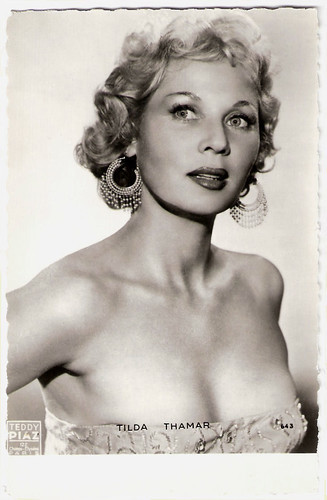
French postcard by Editions P.I., Paris, offered by Les Carbones Korès "Carboplane", no. 643. Photo: Teddy Piaz, Paris.
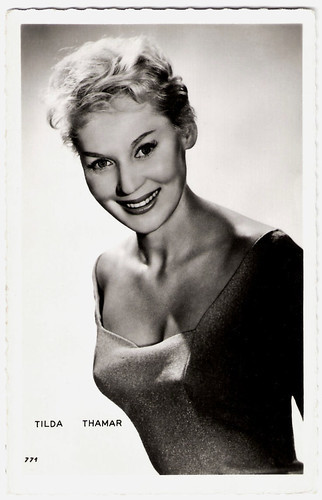
French postcard by Editions P.I., Paris, no. 771. Photo: Studio Vallois.
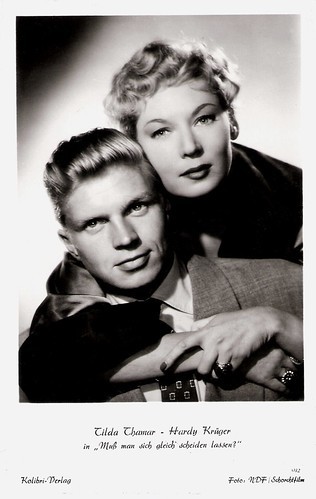
German postcard by Kolibri-Verlag, no. 912. Photo: NDF / Schorchtfilm. Tilda Thamar and Hardy Krüger in Muss man sich gleich scheiden lassen?/Does one have to get divorced right away? (Hans Schweikart, 1953).
Exile in Paris
Tilda Thamar is quoted at Spanish Wikipedia : "Eva Perón had ruled that there was no further filming in Argentina." Thamar left the country and went into exile in Paris. There she was welcomed by the French film industry as the ‘Blonde Bombshell from Argentina’.
She appeared in such French productions as the Film Noir L’ange rouge/The red angel (Jacques Daniel-Norman, 1948) with Paul Meurisse , the crime film Ronde de nuit/Night Watch (François Campaux, 1949), the musical Amour et compagnie/Love and Company (Gilles Grangier, 1949) starring Georges Guétary , and Sérénade au bourreau/Serenade for the executioner (Jean Stelli, 1950).
She also married a certain Count Toptani, but only briefly. Her French films were mostly mediocre gangster films, including Porte d’Orient/Oriental Port (Jacques Daroy. 1950), La femme à l’orchidée/The Woman with the Orchid (Raymond Leboursier, 1951) with Georges Rollin , Massacre en dentelles/Massacre in Lace (André Hunebelle, 1951) with Raymond Rouleau , and Monsieur Scrupule, gangster/Mr. Scrupule, Gangster (Jacques Daroy, 1953).
In Spain, she made El cerco del Diablo/The siege of the devil (Antonio del Amo, Edgar Neville, José Antonio Nieves Conde, Enrique Gómez, Arturo Ruiz Castillo, 1952) with Fernando Rey, and Sor Angélica/Sister Angelica (Joaquín Luis Romero Marchent, 1954).
After the fall of president Péron in 1955, she returned to Argentina to film La mujer desnuda/The Naked Woman (Ernesto Arancibia, 1955) and other films. During the 1950s, she also continued to make films in France and Spain and alternated this with the direction of short films and a feature film in 16 mm. Thamar returned regularly to Argentina.
She showed a passion for drawing and painting and created colourful artworks in the Argentine landscapes of her youth. Thamar studied at the Escuela Nacional de Bellas Artes. In 1956 she married the painter Alejo Vidal Quadras. From the 1960s on, she only appeared incidentally in films.
In 1989, Tilda Thamar died in a car accident in Clermont-en-Argonne in Northern France. She was 71. Her last film was the horror-thriller Los depredadores de la noche/Faceless (Jesús Franco, 1988) starring Helmut Berger .
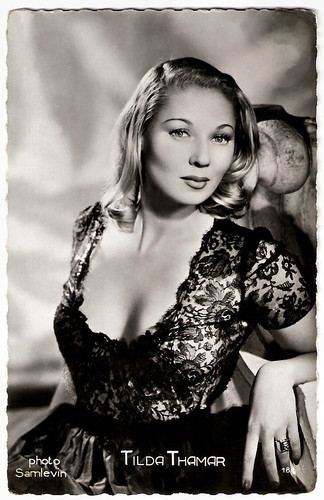
French postcard by Editions P.I., Paris, offered by Les Carbones Korès "Carboplane", no. 182. Photo: Sam Levin.
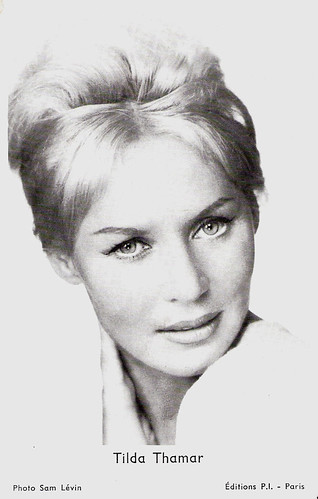
French postcard by Editions P.I., Paris. Photo: Sam Lévin.
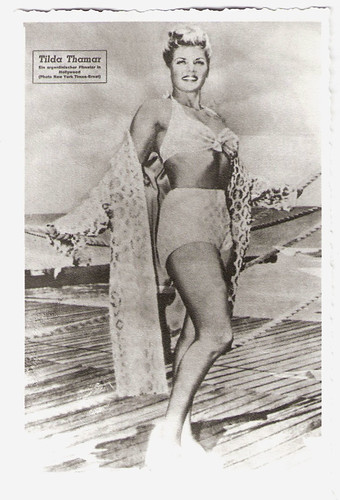
German postcard. Photo: New York Times / Ernst.
Sources: Caroline Hanotte (CinéArtistes - French), Cine Nacional (Spanish), Wikipedia (Spanish, French, and English) and .

French postcard by Editions P.I., Paris, no. 182. Photo: Sam Levin.

French postcard by Editions du Globe, Paris, no. 149. Photo: Sam Lévin.

French postcard by Editions du Globe, Paris, no. 192. Photo: Sam Lévin.
Sculptural Silhouette and blond hair
Tilda Thamar was born Matilda Sofia Abrecht de Vidal Quadras in Urdinarrain, Argentina in 1917 (some sources say 1921). She was the daughter of the German immigrants Martha Nichoerster and Carlos Abrecht. Her father worked as a bookseller and teacher in the German language. In 1925 he opened a book, record and jewelry shop annex photo studio.
Tilda started her career as a teenager with bit roles in Argentine films, such as Don Quijote del altillo/Don Quixote in the attic (Manuel Romero, 1936). She took her stage name from transposing the syllables of the name of her mother Martha (tha-mar). In Segundos afuera!/Seconds out! (Israel Chas de Cruz, Alberto Etchebehere, 1937) starred the boxer Pedrito Quartucci. Eva Duarte (the later Evita Perón) played a small part in it.
The following years Thamar appeared as an extra or bit player in several Argentine films, including El Loco Serenata/The crazy musician (Luis Saslavsky, 1939) with Pepe Arias, Ceniza al viento/Ashes to the wind (Luis Saslavsky, 1941) with Tita Merello, and El espejo/The mirror (Francisco Mugica, 1943) starring Mirtha Legrand.
Her roles got bigger in such popular films as El muerto falta a la cita/The corpse breaks a date (Pierre Chenal, 1944), the comedy La casta Susana/Chaste Susan (Benito Perojo, 1944) based on a German operetta with music by Jean Gilbert, and La señora de Pérez se divorcia/Mrs. Perez and her divorce (Carlos Hugo Christensen, 1945) featuring Mirtha Legrand.
Tilda became increasingly popular thanks to her talent but also to her sculptural silhouette and blond hair. One of her most successful films was Adán y la serpiente/Adam and the Serpent (Carlos Hugo Christensen, 1946), which was the first Argentine film forbidden for minors under 18. Thamar wore a bikini in the film and she was the first Argentine woman who dared to do so.
According to Spanish Wikipedia , she appeared in these Argentine films of the 1940s “not as a femme fatale but as a rogue vampire, who got into the lives of men, gave them a moment of solace and then draw the attention of their unsuspecting wives.”
In 1947, Thamar was offered an attractive contract by the Lumiton studio to make film seven films as their main star. But after only one film, Novio, marido y amante/Boyfriend, husband and love (Mario C. Lugones, 1948), her Argentine career stopped. The Peronist censors had cut several scenes from her film.
She also had posed for the noted German-Argentine photographer Annemarie Heinrich, who was charged with exhibiting obscene works. Still in 1991, more than 40 years later, the Buenos Aires municipality declared the closing of an art gallery and police custody of his window, which displayed the same nude photo within the framework of the exhibition 'El espectáculo en la Argentina (1930-1970)'.

French postcard by Editions P.I., Paris, offered by Les Carbones Korès "Carboplane", no. 643. Photo: Teddy Piaz, Paris.

French postcard by Editions P.I., Paris, no. 771. Photo: Studio Vallois.

German postcard by Kolibri-Verlag, no. 912. Photo: NDF / Schorchtfilm. Tilda Thamar and Hardy Krüger in Muss man sich gleich scheiden lassen?/Does one have to get divorced right away? (Hans Schweikart, 1953).
Exile in Paris
Tilda Thamar is quoted at Spanish Wikipedia : "Eva Perón had ruled that there was no further filming in Argentina." Thamar left the country and went into exile in Paris. There she was welcomed by the French film industry as the ‘Blonde Bombshell from Argentina’.
She appeared in such French productions as the Film Noir L’ange rouge/The red angel (Jacques Daniel-Norman, 1948) with Paul Meurisse , the crime film Ronde de nuit/Night Watch (François Campaux, 1949), the musical Amour et compagnie/Love and Company (Gilles Grangier, 1949) starring Georges Guétary , and Sérénade au bourreau/Serenade for the executioner (Jean Stelli, 1950).
She also married a certain Count Toptani, but only briefly. Her French films were mostly mediocre gangster films, including Porte d’Orient/Oriental Port (Jacques Daroy. 1950), La femme à l’orchidée/The Woman with the Orchid (Raymond Leboursier, 1951) with Georges Rollin , Massacre en dentelles/Massacre in Lace (André Hunebelle, 1951) with Raymond Rouleau , and Monsieur Scrupule, gangster/Mr. Scrupule, Gangster (Jacques Daroy, 1953).
In Spain, she made El cerco del Diablo/The siege of the devil (Antonio del Amo, Edgar Neville, José Antonio Nieves Conde, Enrique Gómez, Arturo Ruiz Castillo, 1952) with Fernando Rey, and Sor Angélica/Sister Angelica (Joaquín Luis Romero Marchent, 1954).
After the fall of president Péron in 1955, she returned to Argentina to film La mujer desnuda/The Naked Woman (Ernesto Arancibia, 1955) and other films. During the 1950s, she also continued to make films in France and Spain and alternated this with the direction of short films and a feature film in 16 mm. Thamar returned regularly to Argentina.
She showed a passion for drawing and painting and created colourful artworks in the Argentine landscapes of her youth. Thamar studied at the Escuela Nacional de Bellas Artes. In 1956 she married the painter Alejo Vidal Quadras. From the 1960s on, she only appeared incidentally in films.
In 1989, Tilda Thamar died in a car accident in Clermont-en-Argonne in Northern France. She was 71. Her last film was the horror-thriller Los depredadores de la noche/Faceless (Jesús Franco, 1988) starring Helmut Berger .

French postcard by Editions P.I., Paris, offered by Les Carbones Korès "Carboplane", no. 182. Photo: Sam Levin.

French postcard by Editions P.I., Paris. Photo: Sam Lévin.

German postcard. Photo: New York Times / Ernst.
Sources: Caroline Hanotte (CinéArtistes - French), Cine Nacional (Spanish), Wikipedia (Spanish, French, and English) and .
Published on May 07, 2020 22:00
May 6, 2020
Photo by Bragaglia
Our series Photo by... returns! Every Thursday, we'll do a post on a terrific photographer and today we start with the Italian master Arturo Bragaglia (1893-1962). He had a photographic studio at the Cinecittà, the Roman film studio complex that opened in 1937. From 1942 on, he also taught photography at the Centro Sperimentale di Cinematografia, just opposite Cinecittà.
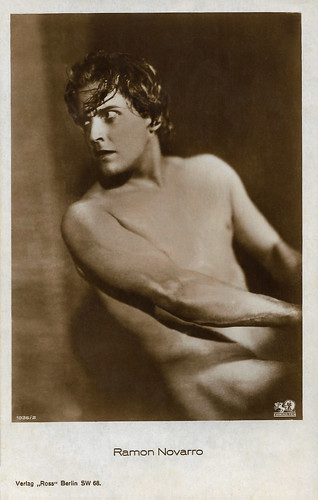
German postcard by Ross Verlag, Berlin, no.1036/2. Photo: Bragaglia / Phoebus Film. Ramon Novarro in Ben-Hur: A Tale of the Christ (Fred Niblo, 1925).
In Ben-Hur: A Tale of the Christ (Fred Niblo, 1925), silent film star Ramon Novarro plays the Jewish prince Judah Ben-Hur, who seeks to find his family and to revenge himself upon his childhood friend Messala (Francis X. Bushman) who had him wrongly imprisoned. A slip of a brick during a Roman parade causes Judah to be sent off as a galley slave, his property confiscated and his mother and sister imprisoned. Years later, as a result of his determination to stay alive and his willingness to aid his Roman master, Judah returns to his homeland an exalted and wealthy Roman athlete. Unable to find his mother and sister, and believing them dead, he can think of nothing else than revenge against Messala. Ramon Novarro was promoted by MGM as a 'Latin Lover' and became known as a sex symbol after the death of Rudolph Valentino. Ben-Hur was Novarro's greatest success. His revealing costumes caused a sensation, just like this picture by Arturo Bragaglia.
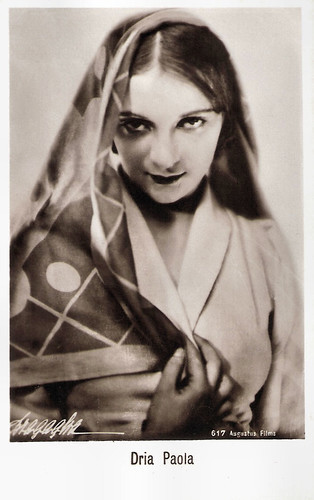
Italian postcard by G.B. Falci Editore, Milano, no. 617. Photo: Bragaglia / Augustus Films.
Dria Paola (1909-1993) was an Italian film actress of the 1930s and 1940s. Her name is attached to the first Italian sound film La canzone dell’amore/The song of love (Gennaro Righelli, 1930).
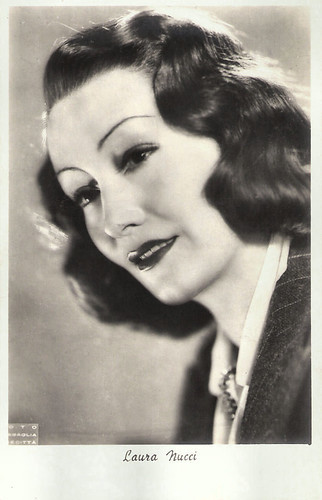
Italian postcard. Photo Bragaglia, Cinecittà, no. 7788.
Italian actress Laura Nucci (1913-1994) was one of the stars of Italian cinema of the 1930s and 1940s. Between 1930 and 1989, she appeared in more than 60 films and TV series.
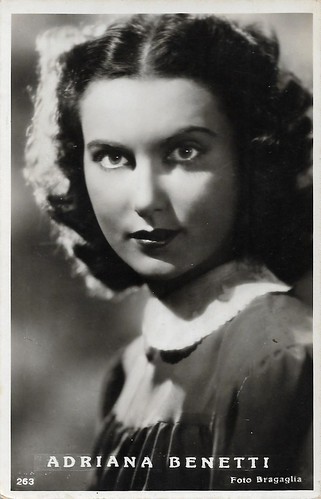
Italian postcard by A. Terzoli, Roma / Stabilimenti Angeli, Terni, no. 263. Photo: Bragaglia.
Adriana Benetti (1919–2016) was an Italian actress, who peaked in the 1940s in films such as Teresa Venerdí/Doctor, Beware (Vittorio De Sica, 1941) and Quattro passi fra le nuvole/Four Steps in the Clouds (Alessandro Blasetti, 1942).
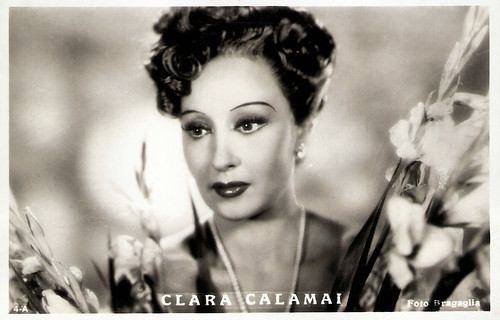
Italian postcard by St. b Angeli, Terni / A. Terzoli, Roma, no. 4.A. Photo: Bragaglia.
Though she acted in many light entertainment films, Clara Calamai 's (1909-1998) most famous role will for always be femme fatale Giovanna in Luchino Visconti's steamy (proto-)neorealist film Ossessione (1943).
The photographic director at Cinecittà
Arturo Bragaglia began his career making photographs in collaboration with his older brother Anton Giulio Bragaglia. His artistic training was developed as an assistant, alongside his brothers, in his father Francesco Bragaglia’s film production company in Rome.
With the publication of his brother Anton Giulio Bragaglia’s book 'Fotodinamismo futurista' (Futurist photodynamism), in 1911, Arturo began collaborating with his brother on photographic experiments. He continued this work until 1932 after Anton Giulio’s focus had shifted to the cinema.
In 1914, Arturo established his own studio. From 1922 until 1928, he was the official photographer of his brothers’ establishment, the Teatro degli Indipendenti, Rome. In 1925, he co-organised the Mostra fotografica italiana (Italian photography exhibition) in Genoa and became a national advisor of the Federazione dei Fotografi.
From 1933 on he was increasingly involved in the cinema, as the photographic director at Cinecittà, Rome, and later as a screenwriter and actor in a number of major productions, such as René Clair’s film La Beauté du diable/Beauty and the Devil (1950) and Vittorio De Sica ’s Miracolo a Milano/Miracle in Milan (1951).
After World War II, Bragaglia continued to work as a photographer, photojournalist, and screenwriter for major directors. He also played a studio photographer in Luchino Visconti's film Bellissima (1951).
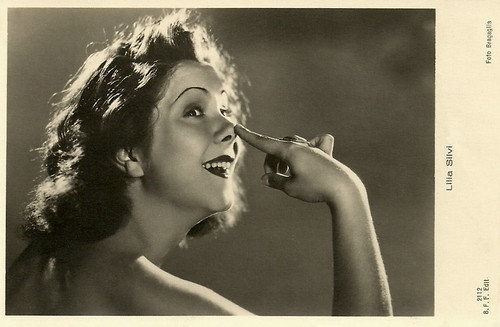
Italian postcard by Ballerini & Fratini, Firenze, no. 2112. Photo: Bragaglia.
Lilia Silvi (born 1921) was a diva of the Italian 'telefoni bianchi' comedies of the 1930s and 1940s, often paired with Amedeo Nazzari . She recently acted in Gianni e le donne (Gianni Di Gregorio 2011) and was the object of the documentary In arte, Lilia Silvi (2011).
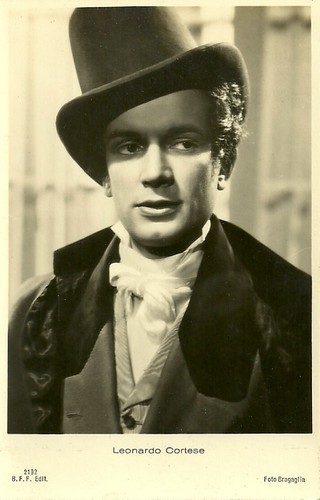
Italian postcard by B.F.F. 2192. Photo: Bragaglia. Cortese's outfit refers to the film Una romantica avventura/A Romantic Adventure (Mario Camerini, 1940).
Leonardo Cortese (1916-1984) was a matinee idol of the Italian cinema of the 1940s. He starred in such films as Sissignora/Yes, Madam (Ferdinando Maria Poggioli, 1941) and Un garibaldino al convento/A Garibaldian in the Convent (Vittorio De Sica, 1942). After the war, he started directing, first films and later on rather focusing on television.
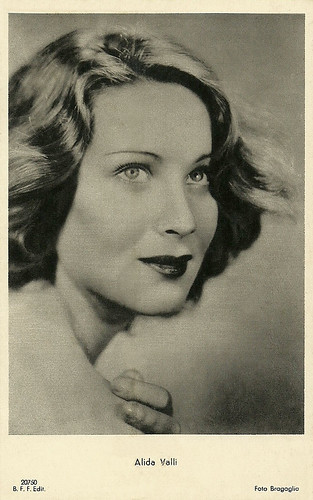
Italian postcard by B.F.F. Edit., no. 20750. Photo: Bragaglia.
Strikingly beautiful actress Alida Valli (1921-2006) was Italy’s Sweetheart of the early 1940s. She fascinated audiences not only with her flawless porcelain face, her dark, voluptuous hair, and her green, expressive eyes but also with her ability to simultaneously hide and reveal a character's thoughts and emotions. In a career that spanned seven decades, she appeared in more than 110 films including such classics as The Third Man (Carol Reed, 1949), The Paradine Case (Alfred Hitchcock, 1947), and Senso (Luchino Visconti, 1954).
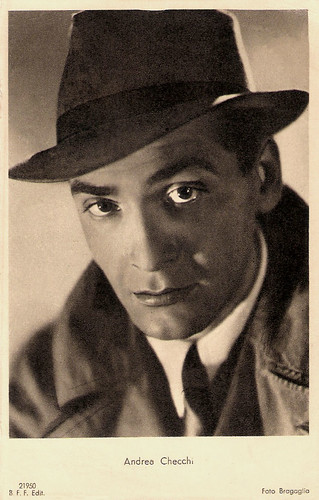
Italian postcard by B.F.F. Edit. (Casa Editrice Ballerini & Fratini Firenze), no. 21950. Photo: Bragaglia.
Andrea Checchi (1916-1974) was a prolific Italian film and television actor, who peaked in the early 1940s as a leading actor, while he had important supporting parts in post-war Neorealism and beyond.
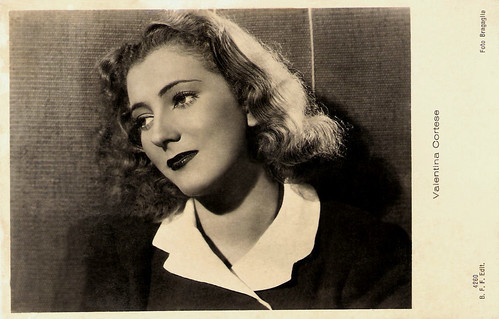
Italian postcard by B.F.F. Edit., Firenze, no. 4260. Photo: Bragaglia.
Italian film and stage actress Valentina Cortese (1923-2019) appeared in more than 100 Italian, French, British and American films and TV series. She was nominated for the Oscar for Best Supporting Actress for her role in Truffaut’s La nuit américaine/Day for Night (1973).
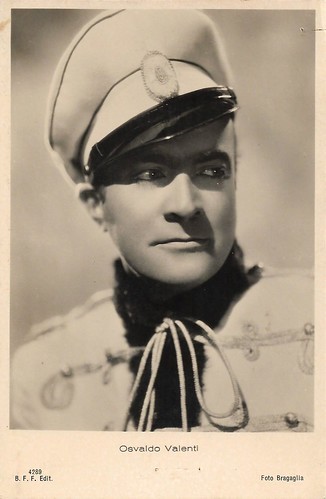
Italian postcard by B.F.F. Edit., no. 4289. Photo: Bragaglia. Osvaldo Valenti in Fedora (Camillo Mastrocinque, 1942).
Osvaldo Valenti (1906-1945) was an Italian film actor, who appeared in 56 films between 1928 and 1945. Thanks to Alessandro Blasetti, he had his breakthrough in the late 1930s and would have major successes - often as the bad guy - in Un'avventura di Salvator Rosa/An Adventure of Salvator Rosa (Alessandro Blasetti, 1939), La corona di ferro/The Iron Crown (Alessandro Blasetti, 1941) and La cena delle beffe/The Jester's Supper (Alessandro Blasetti, 1942). He and his lover, Luisa Ferida , were executed by partisans in Milan, Italy, due to their links with Fascism.
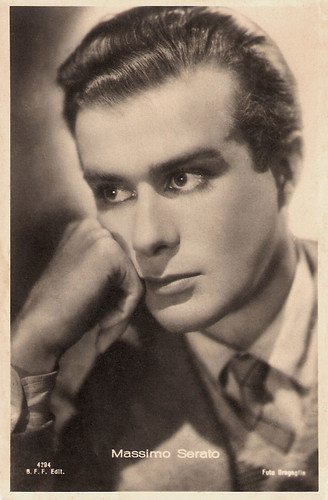
Italian postcard by B. F. F. Edit., no. 4294. Photo: Bragaglia.
Italian film actor Massimo Serato (1916-1989) had a career spanning over 40 years with more than 140 films. He was the virile hero of many sword and sandal epics and historical dramas, mainly in Italy, but he also played roles in major international films.
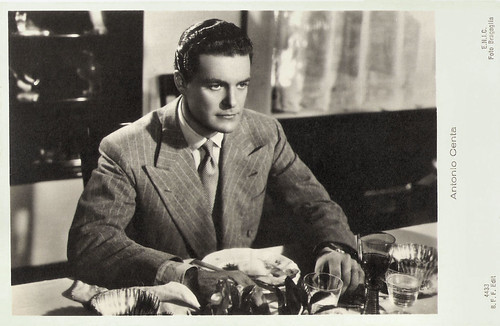
Italian postcard by B.F.F. Edit., no. 4433. Photo: Bragaglia / E.N.I.C.
Between the mid-1930s and 1943, bright and gentle Antonio Centa (1907-1979) was among the most active actors of the Italian cinema. Among female audiences, he was a popular heartthrob in the White Telephone films. The critics praised his performances in Renato Castellani's Un colpo di pistola/A Pistol Shot (1942) and Zazà (1944).
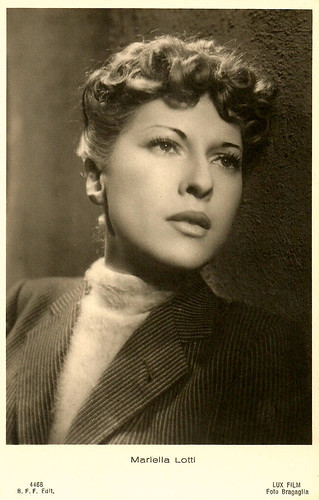
Italian postcard by Ballerini & Fratini Editori, Firenze, no. 4468. Photo: Bragaglia / Lux Film. Mariella Lotti in Quelli della montagna/Those of the Mountain (Aldo Vergano, 1943).
Blonde Italian film actress Mariella Lotti (1921-2006) played leading ladies in a number of Fascist-era and post-war films. The refined beauty quickly became one of the most popular Italian divas of the 1940s.
Source: Mitra Abbaspour (Moma.org).

German postcard by Ross Verlag, Berlin, no.1036/2. Photo: Bragaglia / Phoebus Film. Ramon Novarro in Ben-Hur: A Tale of the Christ (Fred Niblo, 1925).
In Ben-Hur: A Tale of the Christ (Fred Niblo, 1925), silent film star Ramon Novarro plays the Jewish prince Judah Ben-Hur, who seeks to find his family and to revenge himself upon his childhood friend Messala (Francis X. Bushman) who had him wrongly imprisoned. A slip of a brick during a Roman parade causes Judah to be sent off as a galley slave, his property confiscated and his mother and sister imprisoned. Years later, as a result of his determination to stay alive and his willingness to aid his Roman master, Judah returns to his homeland an exalted and wealthy Roman athlete. Unable to find his mother and sister, and believing them dead, he can think of nothing else than revenge against Messala. Ramon Novarro was promoted by MGM as a 'Latin Lover' and became known as a sex symbol after the death of Rudolph Valentino. Ben-Hur was Novarro's greatest success. His revealing costumes caused a sensation, just like this picture by Arturo Bragaglia.

Italian postcard by G.B. Falci Editore, Milano, no. 617. Photo: Bragaglia / Augustus Films.
Dria Paola (1909-1993) was an Italian film actress of the 1930s and 1940s. Her name is attached to the first Italian sound film La canzone dell’amore/The song of love (Gennaro Righelli, 1930).

Italian postcard. Photo Bragaglia, Cinecittà, no. 7788.
Italian actress Laura Nucci (1913-1994) was one of the stars of Italian cinema of the 1930s and 1940s. Between 1930 and 1989, she appeared in more than 60 films and TV series.

Italian postcard by A. Terzoli, Roma / Stabilimenti Angeli, Terni, no. 263. Photo: Bragaglia.
Adriana Benetti (1919–2016) was an Italian actress, who peaked in the 1940s in films such as Teresa Venerdí/Doctor, Beware (Vittorio De Sica, 1941) and Quattro passi fra le nuvole/Four Steps in the Clouds (Alessandro Blasetti, 1942).

Italian postcard by St. b Angeli, Terni / A. Terzoli, Roma, no. 4.A. Photo: Bragaglia.
Though she acted in many light entertainment films, Clara Calamai 's (1909-1998) most famous role will for always be femme fatale Giovanna in Luchino Visconti's steamy (proto-)neorealist film Ossessione (1943).
The photographic director at Cinecittà
Arturo Bragaglia began his career making photographs in collaboration with his older brother Anton Giulio Bragaglia. His artistic training was developed as an assistant, alongside his brothers, in his father Francesco Bragaglia’s film production company in Rome.
With the publication of his brother Anton Giulio Bragaglia’s book 'Fotodinamismo futurista' (Futurist photodynamism), in 1911, Arturo began collaborating with his brother on photographic experiments. He continued this work until 1932 after Anton Giulio’s focus had shifted to the cinema.
In 1914, Arturo established his own studio. From 1922 until 1928, he was the official photographer of his brothers’ establishment, the Teatro degli Indipendenti, Rome. In 1925, he co-organised the Mostra fotografica italiana (Italian photography exhibition) in Genoa and became a national advisor of the Federazione dei Fotografi.
From 1933 on he was increasingly involved in the cinema, as the photographic director at Cinecittà, Rome, and later as a screenwriter and actor in a number of major productions, such as René Clair’s film La Beauté du diable/Beauty and the Devil (1950) and Vittorio De Sica ’s Miracolo a Milano/Miracle in Milan (1951).
After World War II, Bragaglia continued to work as a photographer, photojournalist, and screenwriter for major directors. He also played a studio photographer in Luchino Visconti's film Bellissima (1951).

Italian postcard by Ballerini & Fratini, Firenze, no. 2112. Photo: Bragaglia.
Lilia Silvi (born 1921) was a diva of the Italian 'telefoni bianchi' comedies of the 1930s and 1940s, often paired with Amedeo Nazzari . She recently acted in Gianni e le donne (Gianni Di Gregorio 2011) and was the object of the documentary In arte, Lilia Silvi (2011).

Italian postcard by B.F.F. 2192. Photo: Bragaglia. Cortese's outfit refers to the film Una romantica avventura/A Romantic Adventure (Mario Camerini, 1940).
Leonardo Cortese (1916-1984) was a matinee idol of the Italian cinema of the 1940s. He starred in such films as Sissignora/Yes, Madam (Ferdinando Maria Poggioli, 1941) and Un garibaldino al convento/A Garibaldian in the Convent (Vittorio De Sica, 1942). After the war, he started directing, first films and later on rather focusing on television.

Italian postcard by B.F.F. Edit., no. 20750. Photo: Bragaglia.
Strikingly beautiful actress Alida Valli (1921-2006) was Italy’s Sweetheart of the early 1940s. She fascinated audiences not only with her flawless porcelain face, her dark, voluptuous hair, and her green, expressive eyes but also with her ability to simultaneously hide and reveal a character's thoughts and emotions. In a career that spanned seven decades, she appeared in more than 110 films including such classics as The Third Man (Carol Reed, 1949), The Paradine Case (Alfred Hitchcock, 1947), and Senso (Luchino Visconti, 1954).

Italian postcard by B.F.F. Edit. (Casa Editrice Ballerini & Fratini Firenze), no. 21950. Photo: Bragaglia.
Andrea Checchi (1916-1974) was a prolific Italian film and television actor, who peaked in the early 1940s as a leading actor, while he had important supporting parts in post-war Neorealism and beyond.

Italian postcard by B.F.F. Edit., Firenze, no. 4260. Photo: Bragaglia.
Italian film and stage actress Valentina Cortese (1923-2019) appeared in more than 100 Italian, French, British and American films and TV series. She was nominated for the Oscar for Best Supporting Actress for her role in Truffaut’s La nuit américaine/Day for Night (1973).

Italian postcard by B.F.F. Edit., no. 4289. Photo: Bragaglia. Osvaldo Valenti in Fedora (Camillo Mastrocinque, 1942).
Osvaldo Valenti (1906-1945) was an Italian film actor, who appeared in 56 films between 1928 and 1945. Thanks to Alessandro Blasetti, he had his breakthrough in the late 1930s and would have major successes - often as the bad guy - in Un'avventura di Salvator Rosa/An Adventure of Salvator Rosa (Alessandro Blasetti, 1939), La corona di ferro/The Iron Crown (Alessandro Blasetti, 1941) and La cena delle beffe/The Jester's Supper (Alessandro Blasetti, 1942). He and his lover, Luisa Ferida , were executed by partisans in Milan, Italy, due to their links with Fascism.

Italian postcard by B. F. F. Edit., no. 4294. Photo: Bragaglia.
Italian film actor Massimo Serato (1916-1989) had a career spanning over 40 years with more than 140 films. He was the virile hero of many sword and sandal epics and historical dramas, mainly in Italy, but he also played roles in major international films.

Italian postcard by B.F.F. Edit., no. 4433. Photo: Bragaglia / E.N.I.C.
Between the mid-1930s and 1943, bright and gentle Antonio Centa (1907-1979) was among the most active actors of the Italian cinema. Among female audiences, he was a popular heartthrob in the White Telephone films. The critics praised his performances in Renato Castellani's Un colpo di pistola/A Pistol Shot (1942) and Zazà (1944).

Italian postcard by Ballerini & Fratini Editori, Firenze, no. 4468. Photo: Bragaglia / Lux Film. Mariella Lotti in Quelli della montagna/Those of the Mountain (Aldo Vergano, 1943).
Blonde Italian film actress Mariella Lotti (1921-2006) played leading ladies in a number of Fascist-era and post-war films. The refined beauty quickly became one of the most popular Italian divas of the 1940s.
Source: Mitra Abbaspour (Moma.org).
Published on May 06, 2020 22:00
May 5, 2020
Lucien Dalsace
Well-built and handsome Lucien Dalsace (1893-1980) was a French stage and screen actor who peaked in the French silent cinema of the 1920s. He went from success to success in films directed by Louis Feuillade, René Leprince, Gaston Ravel, René Hervil and Henri Desfontaines.
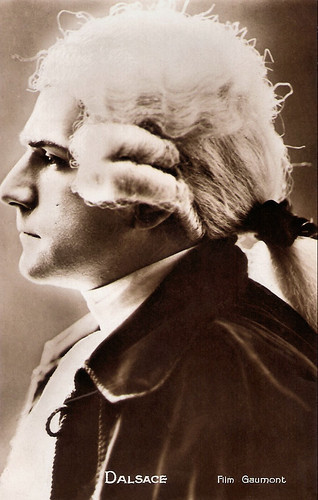
French postcard. Photo: Film Gaumont. Lucien Dalsace in Vindicta (Louis Feuillade, 1923).
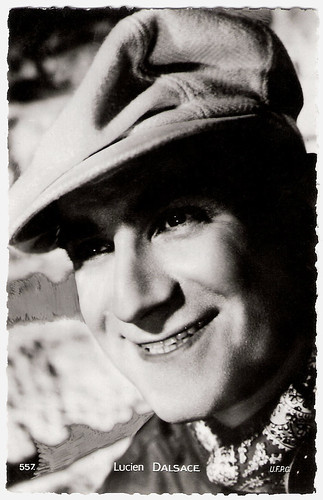
French postcard by Collection Chantal, Paris, no. 557. Photo: U.F.P.C.
An aviation hero during the First World War
Lucien Dalsace was born Gustave Louis Chalot in 1983 in Chatou, a town near Paris popular among the bourgeoisie and artists at the time. Gustave was destined by his industrialist father for a job in the silk industry.
Guy Bellinger at IMDb : "But Chalot senior had overlooked something important: one of Gustave's great-aunts, Marie Bilhaut, had been a renowned resident at the Comédie-Française while one of his great-uncles had been an opera singer. As a result of the presence of Thespis in the family genes, it comes as no surprise that as of his high school years young Gustave organized theater performances with and for his schoolmates."
After passing his final exams Gustave obeyed his father and followed training in the silk industry. At the same time, he appeared incognito in several plays in small theatres. When Gustave's father became aware of what was happening he understood that his son's passion for the theatre was too strong to be resisted.
World War I interrupted this fledgling career though. Gustave was drafted into the Third Battalion of Chasseurs where, despite this major inconvenience, he had the opportunity to meet the famous actor Jean Toulout . It was the beginning of a solid and lasting friendship. Gustave then transferred into the Air Force and took part in many air battles. He also organised performances for his war mates.
After being an aviation hero during the war, Gustave resumed his acting career as Lucien Dalsace this time. Signed by Léon Volterra, the owner of the Théâtre de Paris, he found himself very much in demand as a romantic lead. It was the start of a prolific career in both the theatre and the cinema.
Guy Bellinger: "His great presence, his manly appearance, his handsome face could not remain unnoticed by the movies for long and he debuted top-billed in La brute in 1921. Two years later his double role in the eight-chapter serial L'aviateur made him a true star."
Between 1921 and 1929, Lucien Dalsace participated in 26 silent films. In his above-mentioned debut La Brute/The Brute (Daniel Bompard, 1921), he appeared opposite Louise Storza, André Nox , and Suzanne Bianchetti .
After the serial L'aviateur masqué/The masked aviator (Robert Péguy, 1922), in which he played a double role, he worked again with director Robert Péguy on Le Crime de Monique/Monique's crime (Robert Péguy, 1922) featuring Yvette Andréyor , and Le Vol/The flight (Robert Péguy, 1923) with Charles Vanel and Denise Legeay. Subsequently, he played the Marquis of Saint-Estelle in Vindicta (1923) one of the last films by pioneer director Louis Feuillade.
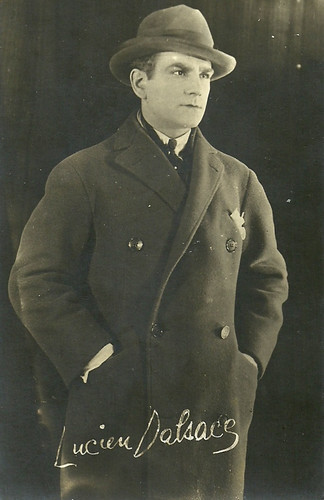
French postcard, editor unknown.
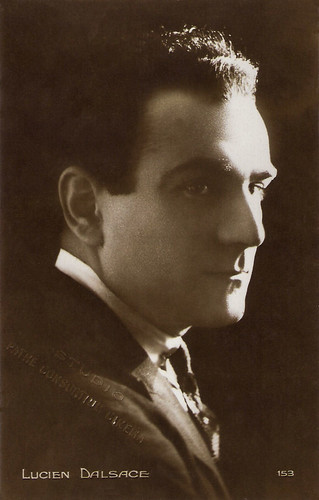
French postcard by Editions Cinémagazine, no. 153.
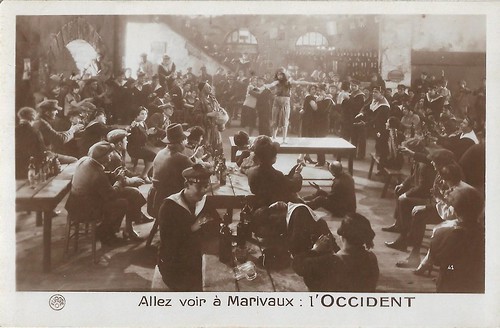
French postcard for the French silent film L'Occident (Henri Fescourt, 1927, released 1928) by Europe, no. 41. The card makes publicity for the film's premiere screening at the Paris cinema Marivaux. Caption from La Petite Illustration, 398, 1928: "Taïeb forces young Fathima to dance in a den in Toulon."
A matinée idol on a secret mission
In 1924-1925, Lucien Dalsace did a whole string of films with Gaston Roudès: Féliana l'espionne/Feliana the spy (Gaston Roudès, 1924) featuring France Dhélia , Les Petits/The Little Ones (Marcel Dumont, Gaston Roudès, 1925), La Douleur/Pain (Gaston Roudès, 1925) with Constant Rémy, La Maternelle/Petite mère/Kindergarten (Gaston Roudès, 1925) starring France Dhélia , and Oiseaux de passage/Passing birds (Gaston Roudès, 1925).
In Ferragus (Gaston Ravel, 1923), based on the novel by Honoré de Balzac, the title character ( René Navarre ), the head of a Parisian secret society and an ex-convict wants to get rid of a young suitor (Dalsace) of his protegée ( Elmire Vautier ).
In the fantasy Belphégor (Henri Desfontaines, 1927), Dalsace is Bellegarde, a journalist keen on solving a murder and theft case at the Louvre, by a ghostlike figure, called Belphégor, and his gang. While the Police Inspector (Georges Paulais) suspects Bellegarde, a private detective, Chantecoq ( René Navarre ), knows better.
In L'Occident/The West (Henri Fescourt, 1928), set on the Moroccan coast, Captain Jean Cadière (Lucien Dalsace), is sent on a secret mission to prevent rebels attacking caravans. He is helped by Hassina (Claudia Victrix), a captive of the rebel tribe of Zerreth-Hama, but the tribe leader, Taïeb (Hugues de Bagratide) discovers this. He threatens to burn alive Hassina's little sister Fathima (Andrée Rolane). See our special blog on this film.
In Le Prince Jean/Bonds of Honour (René Hervil, 1929), Dalsace is a prince ruined at the gambling tables, so he leaves his beloved Claire (Renée Héribel) behind. Then Claire marries a banker, Arnheim (Paul Guidé), and finds out that he plotted to ruin Prince Jean, in order to marry her.
In Hervil's Le Ruisseau/The Stream (René Hervil, 1929), Dalsace is a celebrated painter who loves a rich and divorced woman (Olga Day), who cheats him. To comfort himself, he goes to Montmartre and finds a poor but honest girl ( Louise Lagrange ).
By the end of the silent era, Dalsace's prime was over. History repeated itself. His career was once again interrupted and the culprit this time was the coming of sound. Lucien Dalsace, still a matinée idol a few months before, had abruptly gone unfashionable. Getting no more roles, Lucien/Gustave changed jobs and became a perfume merchant in the Latin Quarter.
Dalsace made his comeback in 1937. For his old friend Léon Mathot, he returned before the cameras to play old Georges in Chéri-Bibi (Léon Mathot, 1937) alongside Pierre Fresnay in the title role. For Mathot, he also played opposite in Pierre Renoir in Le révolté/The Rebel (Léon Mathot, 1938), then an officer in Rappel immédiat/Immediate Call (Léon Mathot, 1939) with Erich von Stroheim .
In 1941, he returned to trade. His final film was the adventure Patrouille blanche/White patrol (Christian Chamborant, 1941), starring Sessue Hayakawa and Junie Astor .
Lucien Dalsace died in oblivion in 1980 at home in L'Hay-les-Roses, Val-de-Marne, France. He was 87. With his wife of many years, actress Jane Marceau, he had one child.

French postcard in the Les Vedettes de Cinéma series by A.N., Paris, no. 74. Photo: G.L. Manuel Frères.
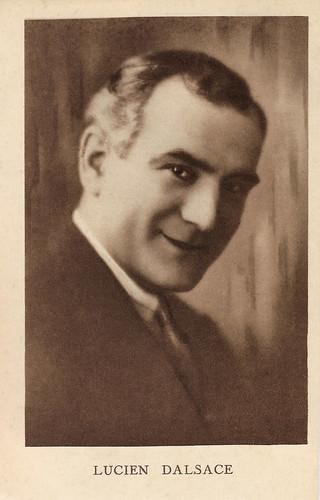
Belgian postcard by Weekblad 'Cinema', Antwerpen (ed. journal Cinema, Antwerp).
Sources: Philippe Pelletier (Ciné-Artistes - French), (IMDb), Wikipedia (French) and .

French postcard. Photo: Film Gaumont. Lucien Dalsace in Vindicta (Louis Feuillade, 1923).

French postcard by Collection Chantal, Paris, no. 557. Photo: U.F.P.C.
An aviation hero during the First World War
Lucien Dalsace was born Gustave Louis Chalot in 1983 in Chatou, a town near Paris popular among the bourgeoisie and artists at the time. Gustave was destined by his industrialist father for a job in the silk industry.
Guy Bellinger at IMDb : "But Chalot senior had overlooked something important: one of Gustave's great-aunts, Marie Bilhaut, had been a renowned resident at the Comédie-Française while one of his great-uncles had been an opera singer. As a result of the presence of Thespis in the family genes, it comes as no surprise that as of his high school years young Gustave organized theater performances with and for his schoolmates."
After passing his final exams Gustave obeyed his father and followed training in the silk industry. At the same time, he appeared incognito in several plays in small theatres. When Gustave's father became aware of what was happening he understood that his son's passion for the theatre was too strong to be resisted.
World War I interrupted this fledgling career though. Gustave was drafted into the Third Battalion of Chasseurs where, despite this major inconvenience, he had the opportunity to meet the famous actor Jean Toulout . It was the beginning of a solid and lasting friendship. Gustave then transferred into the Air Force and took part in many air battles. He also organised performances for his war mates.
After being an aviation hero during the war, Gustave resumed his acting career as Lucien Dalsace this time. Signed by Léon Volterra, the owner of the Théâtre de Paris, he found himself very much in demand as a romantic lead. It was the start of a prolific career in both the theatre and the cinema.
Guy Bellinger: "His great presence, his manly appearance, his handsome face could not remain unnoticed by the movies for long and he debuted top-billed in La brute in 1921. Two years later his double role in the eight-chapter serial L'aviateur made him a true star."
Between 1921 and 1929, Lucien Dalsace participated in 26 silent films. In his above-mentioned debut La Brute/The Brute (Daniel Bompard, 1921), he appeared opposite Louise Storza, André Nox , and Suzanne Bianchetti .
After the serial L'aviateur masqué/The masked aviator (Robert Péguy, 1922), in which he played a double role, he worked again with director Robert Péguy on Le Crime de Monique/Monique's crime (Robert Péguy, 1922) featuring Yvette Andréyor , and Le Vol/The flight (Robert Péguy, 1923) with Charles Vanel and Denise Legeay. Subsequently, he played the Marquis of Saint-Estelle in Vindicta (1923) one of the last films by pioneer director Louis Feuillade.

French postcard, editor unknown.

French postcard by Editions Cinémagazine, no. 153.

French postcard for the French silent film L'Occident (Henri Fescourt, 1927, released 1928) by Europe, no. 41. The card makes publicity for the film's premiere screening at the Paris cinema Marivaux. Caption from La Petite Illustration, 398, 1928: "Taïeb forces young Fathima to dance in a den in Toulon."
A matinée idol on a secret mission
In 1924-1925, Lucien Dalsace did a whole string of films with Gaston Roudès: Féliana l'espionne/Feliana the spy (Gaston Roudès, 1924) featuring France Dhélia , Les Petits/The Little Ones (Marcel Dumont, Gaston Roudès, 1925), La Douleur/Pain (Gaston Roudès, 1925) with Constant Rémy, La Maternelle/Petite mère/Kindergarten (Gaston Roudès, 1925) starring France Dhélia , and Oiseaux de passage/Passing birds (Gaston Roudès, 1925).
In Ferragus (Gaston Ravel, 1923), based on the novel by Honoré de Balzac, the title character ( René Navarre ), the head of a Parisian secret society and an ex-convict wants to get rid of a young suitor (Dalsace) of his protegée ( Elmire Vautier ).
In the fantasy Belphégor (Henri Desfontaines, 1927), Dalsace is Bellegarde, a journalist keen on solving a murder and theft case at the Louvre, by a ghostlike figure, called Belphégor, and his gang. While the Police Inspector (Georges Paulais) suspects Bellegarde, a private detective, Chantecoq ( René Navarre ), knows better.
In L'Occident/The West (Henri Fescourt, 1928), set on the Moroccan coast, Captain Jean Cadière (Lucien Dalsace), is sent on a secret mission to prevent rebels attacking caravans. He is helped by Hassina (Claudia Victrix), a captive of the rebel tribe of Zerreth-Hama, but the tribe leader, Taïeb (Hugues de Bagratide) discovers this. He threatens to burn alive Hassina's little sister Fathima (Andrée Rolane). See our special blog on this film.
In Le Prince Jean/Bonds of Honour (René Hervil, 1929), Dalsace is a prince ruined at the gambling tables, so he leaves his beloved Claire (Renée Héribel) behind. Then Claire marries a banker, Arnheim (Paul Guidé), and finds out that he plotted to ruin Prince Jean, in order to marry her.
In Hervil's Le Ruisseau/The Stream (René Hervil, 1929), Dalsace is a celebrated painter who loves a rich and divorced woman (Olga Day), who cheats him. To comfort himself, he goes to Montmartre and finds a poor but honest girl ( Louise Lagrange ).
By the end of the silent era, Dalsace's prime was over. History repeated itself. His career was once again interrupted and the culprit this time was the coming of sound. Lucien Dalsace, still a matinée idol a few months before, had abruptly gone unfashionable. Getting no more roles, Lucien/Gustave changed jobs and became a perfume merchant in the Latin Quarter.
Dalsace made his comeback in 1937. For his old friend Léon Mathot, he returned before the cameras to play old Georges in Chéri-Bibi (Léon Mathot, 1937) alongside Pierre Fresnay in the title role. For Mathot, he also played opposite in Pierre Renoir in Le révolté/The Rebel (Léon Mathot, 1938), then an officer in Rappel immédiat/Immediate Call (Léon Mathot, 1939) with Erich von Stroheim .
In 1941, he returned to trade. His final film was the adventure Patrouille blanche/White patrol (Christian Chamborant, 1941), starring Sessue Hayakawa and Junie Astor .
Lucien Dalsace died in oblivion in 1980 at home in L'Hay-les-Roses, Val-de-Marne, France. He was 87. With his wife of many years, actress Jane Marceau, he had one child.

French postcard in the Les Vedettes de Cinéma series by A.N., Paris, no. 74. Photo: G.L. Manuel Frères.

Belgian postcard by Weekblad 'Cinema', Antwerpen (ed. journal Cinema, Antwerp).
Sources: Philippe Pelletier (Ciné-Artistes - French), (IMDb), Wikipedia (French) and .
Published on May 05, 2020 22:00
Paul van Yperen's Blog
- Paul van Yperen's profile
- 13 followers
Paul van Yperen isn't a Goodreads Author
(yet),
but they
do have a blog,
so here are some recent posts imported from
their feed.



